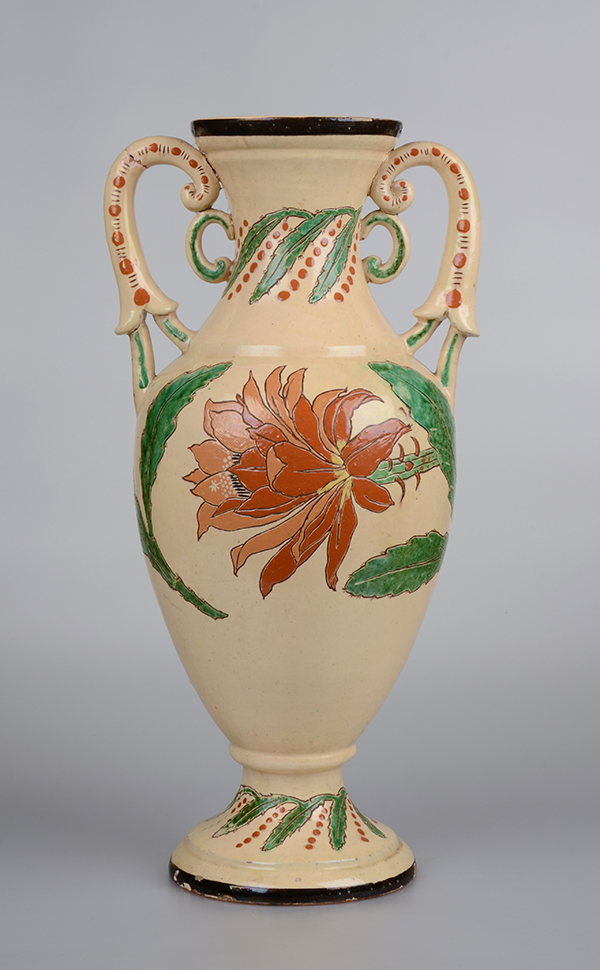
Vase by Johann Röthlisberger; according to family lore it was made for the 1914 Swiss National Exhibition in Bern.
Ceramics made by the Röthlisberger pottery in CERAMICA CH
Andreas Heege, Andreas Kistler 2022
With support from the Langnau Regional Museum and the Wüthrich and Brechbühl families in Langnau.
The family background
In the potter’s workshop at “Im Kohlboden” (Bärau, 6 Styggässli), we encounter yet another family of potters who played a role in Langnau’s pottery industry during the second half of the 19th and first half of the 20th centuries (paper first published in: Heege/Kistler 2017, 188-193; reproduced here with significant additions).
Mathys Röthlisberger was a bricklayer and father of eight children; his wife was Anna Blaser from Langnau (citizens’ register for Langnau [henceforth BRL] 7, 27). Three of their sons became potters (family tree): Ulrich Röthlisberger (1837–1888; BRL 7, 27; BRL 14, 440, married to Marianne Lüthi from Lauperswil, church register for Langnau [KRL] 29, 20; 28/11/1862), Friedrich Röthlisberger (1846–1920; BRL 7, 27; BRL 17, 40, married to Anna Maibach from Dürrenroth, KRL 30, 1; 23/7/1870) and Simon Röthlisberger (1855–1894; BRL 7, 27; BRL 19, 11, married to Maria Anna Gerber from Langnau; 8/4/1881).
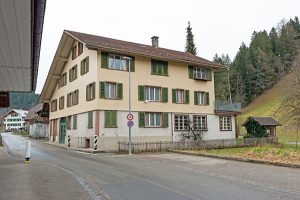
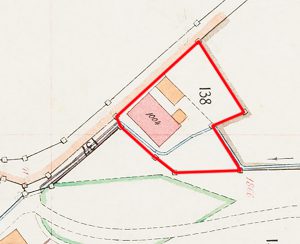
Bärau, Styggässli 6 in 2016.
In 1864, Mathys Röthlisberger and his son Christen sold a property “in the Kohlboden area near the smithy” in Bärau (now 6 Styggässli, plot no. 1814), which they had bought in 1862, to Ulrich, another of Mathys’s sons. At the time of the sale, Ulrich lived (and worked?) in Signau, where his first daughter Lina was born (18th January 1864, KRL 20, 401). He added a potter’s workshop to the house in Bärau (cadastral register for Langnau [GBL] 29, 73–79), where he produced his pottery until the autumn of 1877. The Langnau register of voters lists two journeymen, one from Busswil near Melchnau, the other from Langnau, as working at the workshop during this time. It is possible that the potter Christian Herrmann (1848-?) also worked there until 1876 (Langnau municipal archive [GAL] 672). In August 1877, Ulrich sold the property to his brothers Mathias and Gottlieb. His fate after that is not clear, but the Langnau voters’ register for January 1878 lists him as being under guardianship (GAL 672). In November 1878, his brothers sold the workshop to master potter Christian Wüthrich from Trub. At that time, Wüthrich was described in records as a “master potter in Zäziwil” (GBL 47, 501–509; GBL 48, 186–194). No ceramics can be attributed to Ulrich Röthlisberger, and no archaeological finds are known to have come to light at the property.
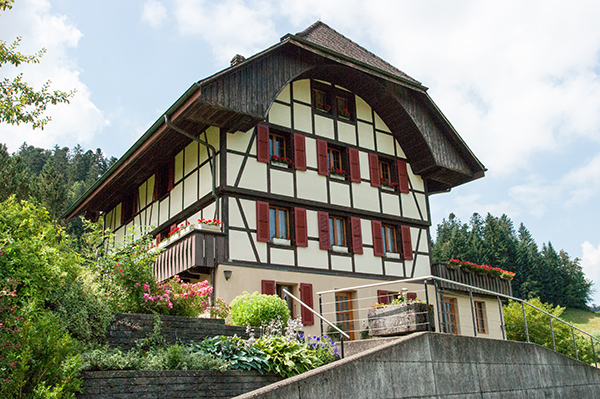
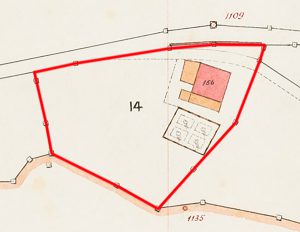
Langnau, 225 Moos in 2016.
Friedrich Röthlisberger (1846–1920; BRL 17, 40; GAL 672), Ulrich Röthlisberger’s (1837–1888, potter in Bärau) younger brother, married Anna Maibach (1848–1893) from Dürrenroth on 23rd July 1870 in Muri. The baptismal record of his eldest son Friedrich junior (1872–1952; BRL 17, 40), who was baptised in Rohrbach, lists Friedrich as a “potter in Leimiswil” (KRL 21, 380). In 1873/74, Friedrich senior and master bricklayer Christian Lehmann from Langnau got together to build a residence and potter’s workshop “auf dem Moos” (today 225 Moos in Langnau, plot no. 864; GBL 40, 313–317; GBL 41, 458–462). This was where Friedrich’s second and third sons, (Friedrich) Johann (1876–1942) and Julius Maximilian (1879–1959) were born (BRL 17, 40). All three of his sons later worked, at least temporarily, as potters at a new workshop at 66 Oberstrasse in Langnau (GAL 674, 675; BRL 23, 604; BRL 24, 178). Between 1874 and 1890, the couple had another nine children, but Anna Maibach died in 1893. From 1874 until 1894, Friedrich Röthlisberger (1846–1920) and his brother Simon (1855–1894) worked together at this workshop. As many as six journeymen were recorded for this period, including one called Ernst Röthlisberger (1863–?; GAL 672, 673. The genealogical links have not been investigated). Friedrich then sold his half of the property to his co-owner’s widow. Following her death, the house and workshop passed to her son, who was a railway worker (GBL 71, 283–289; GBL 71, 578–582; GBL 72, 567–573). Although the potter’s workshop was still mentioned in records at that stage, no evidence has been found to prove that pottery was still being produced at the property after 1894, when Friedrich Röthlisberger (1846–1920) moved to 66 Oberstrasse in Langnau. No products have survived from the workshop at 225 Moos, nor have any archaeological finds come to light at the property.
Langnau, 66 Oberstrasse
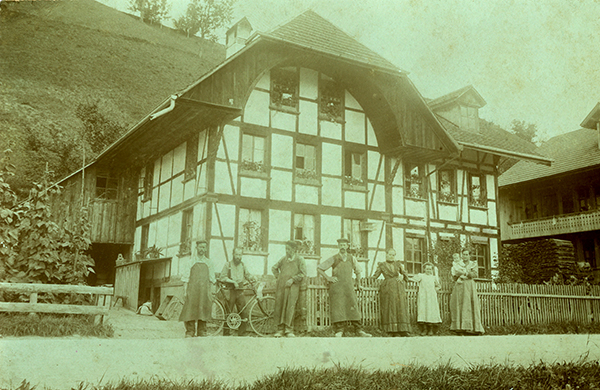
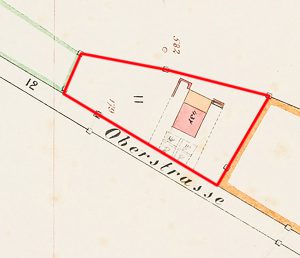
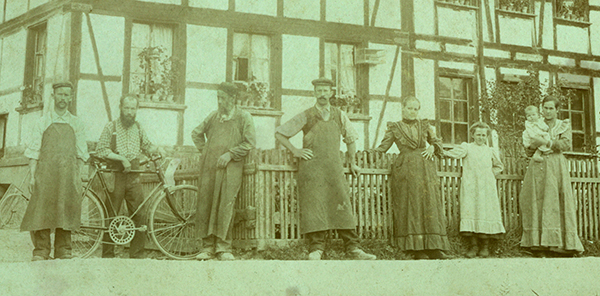
Langnau, 66 Oberstrasse. Friedrich Röthlisberger (1846–1920, third from left) and his three sons, Julius Maximilian, Friedrich and Johann; picture taken in front of their house in c. 1910.
On 12th May 1894, Friedrich Röthlisberger (1846–1920) purchased a property with a dwelling, a vegetable garden and a well at “am Gassenberg” in Langnau (now plot no. 1425, see the plan). The contract stated, however, that he could start extending the property by adding a potter’s workshop even before that date. We can probably assume that he ran the workshop together with his three sons, Friedrich junior (1872–1952, unmarried), Friedrich Johann (known only as Johann, 1876–1942) and Julius Maximilian (1879–1959). We do not know if his late brother Simon’s widow and six children also lived there; in any case, they are not listed in the 1920 census for Langnau (GAL 1065).
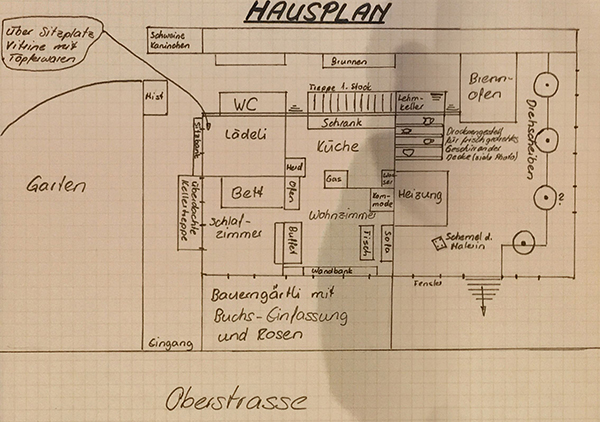
Ground floor plan of the potter’s workshop on Oberstrasse, as recalled by Veronika Wüthrich-Brechbühl.
The Röthlisberger family lived in fairly cramped conditions because part of the house and the first floor of the extension were rented out. The pottery was on the ground floor of the extension and included three or four potters’ wheels and a pottery paintress’s workstation. The drying rack where the freshly thrown pots were kept was located right beside the workshop heater. The kiln was in the rear of the workshop facing the slope. The clay cellar was below the workshop. Partitioned off from the living area was a small shop for selling crockery with an outside showcase.
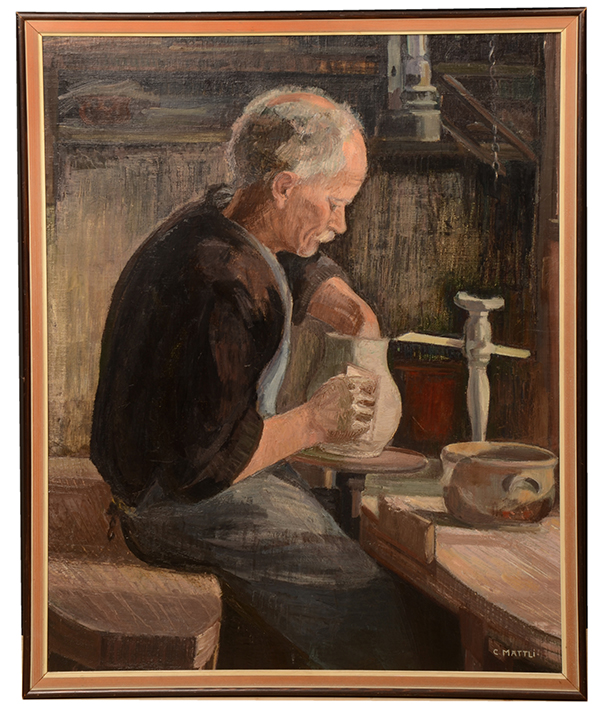
Johann Röthlisberger at the workshop, undated painting, now in the Langnau Regional Museum, c. 1930-1940.
Friedrich’s son Johann was married to Anna Brechbühl (1880–1961) from Langnau. The couple had no children.
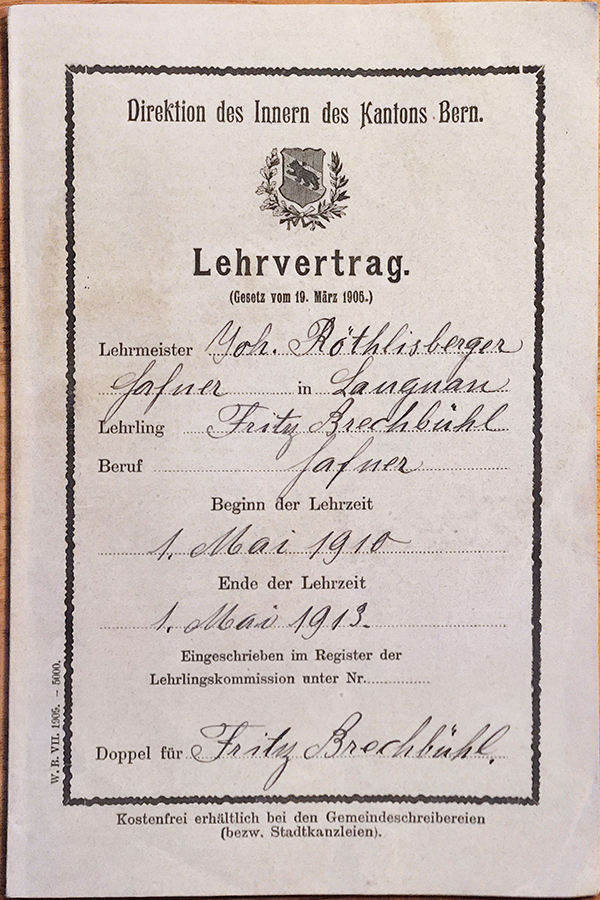
Anna Brechbühl had a brother called Fritz (1893–1954). Because their mother died relatively young, Fritz Brechbühl was taken in by the Röthlisberger family and trained as a potter in their workshop from 1910 to 1913. As prescribed by cantonal law, he was given an apprenticeship contract. It stipulated the period of training (3 years), the pay (100 Swiss francs), the working hours (11 hours per day) and annual leave (4 days). During the apprenticeship, he had to attend the vocational school for craftspeople in Langnau.
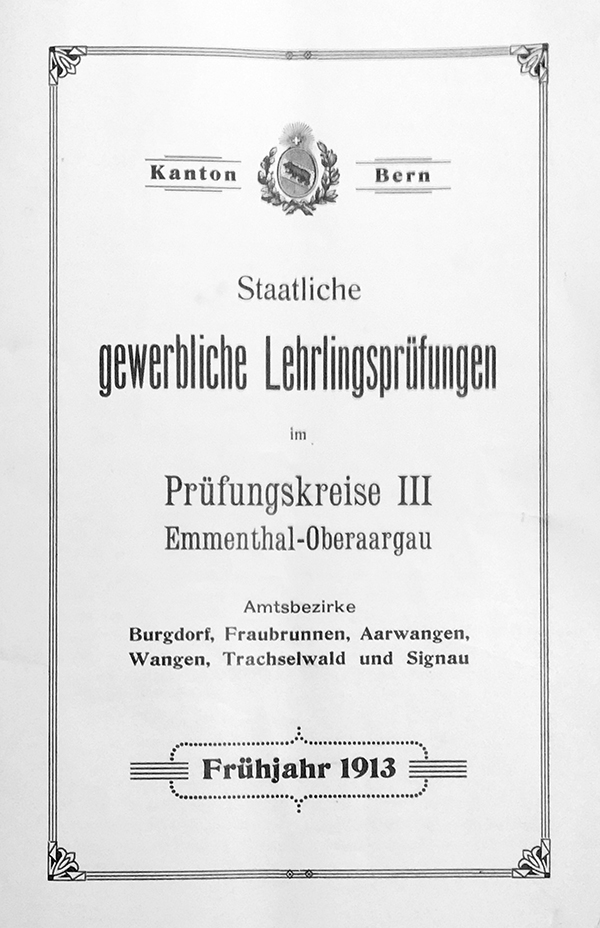
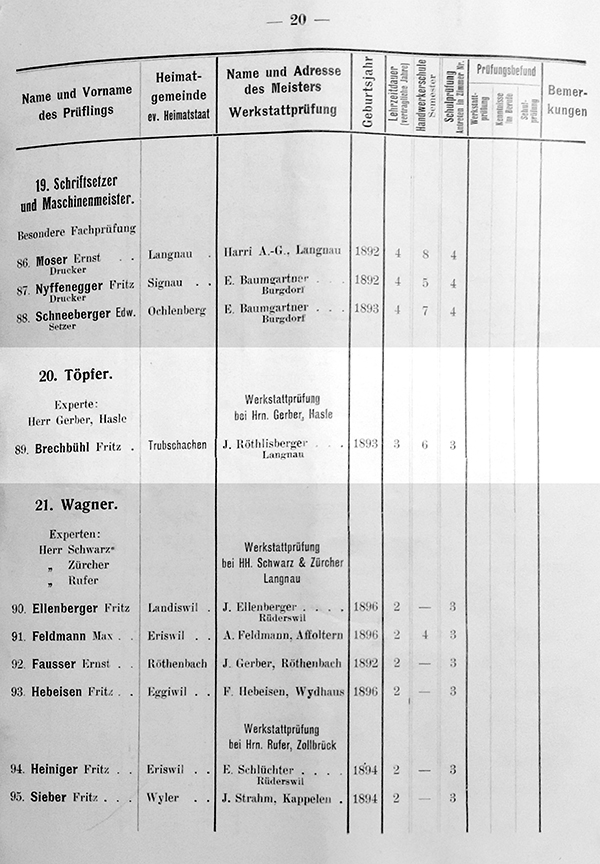
In 1913, he successfully sat his final exam at the workshop of Adolf Gerber in Hasle.
d.
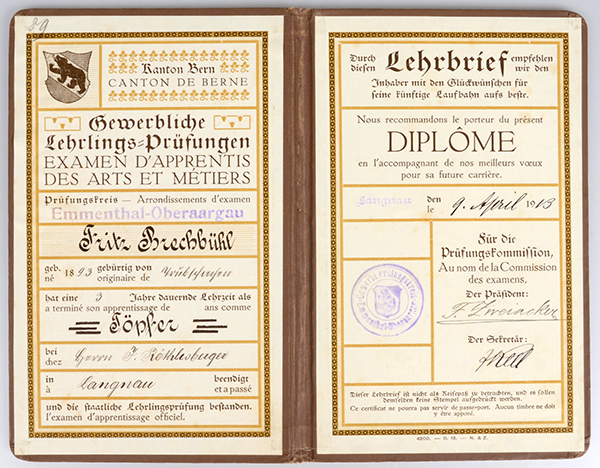
Fritz Brechbühl’s certificate of apprenticeship, 1910-1913; such documents rarely survive.
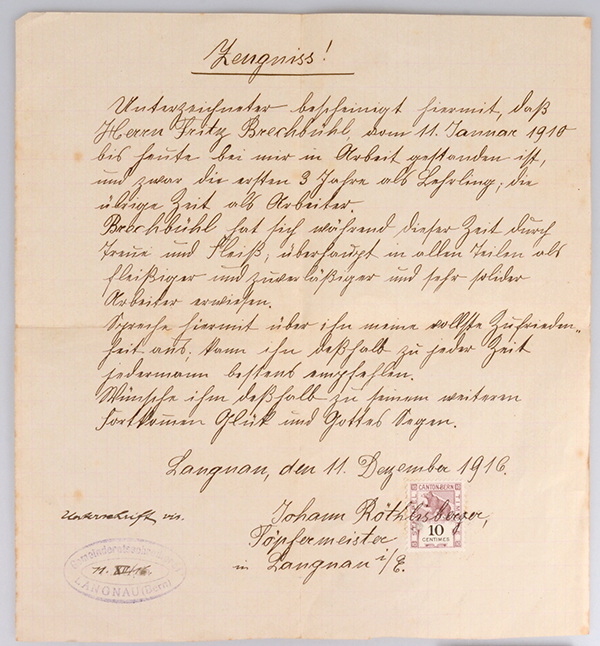
Reference for Fritz Brechbühl, 1916, signed by master potter Johann Röthlisberger.
In 1914/1915, Fritz served as a soldier on the Swiss border. According to the reference shown above, we know that he continued to work for the Röthlisbergers as a journeyman, at least until 1916.
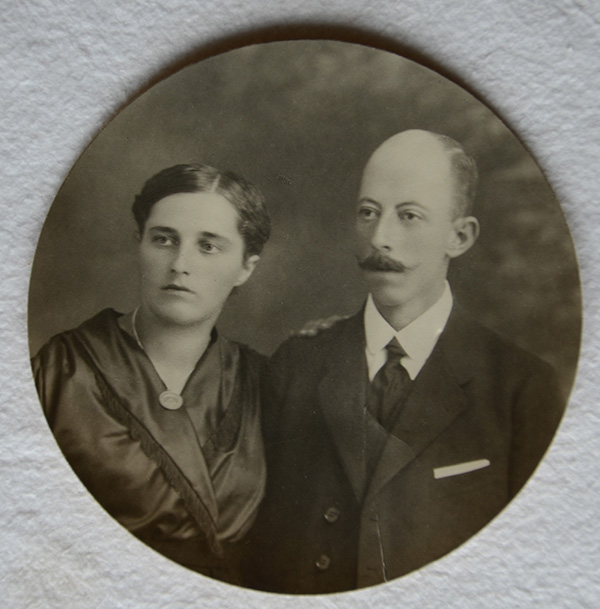
Fritz Brechbühl and Emma Jakob.
In the 1920s he gave up his job as a potter and became a postman, though he continued to help out at the workshop. In 1926 he married Emma Jakob. Their daughter Veronika married Christian Wüthrich (1924-2020), and it was through her that important objects and documents from the Röthlisberger workshop and from the personal belongings of Fritz Brechbühl passed down to the Wüthrich family and were thus preserved.
When Friedrich Röthlisberger died (on 12th September 1920), Friedrich junior (1872–1952) and Johannes (1876–1942) jointly inherited the property, as they were still working as potters (GBS Bel. I, 3581–3583). Their brother Julius Maximilian was already working as a pointsman for the Swiss Railway company SBB. Pottery production at the workshop continued after the deaths of Johannes (29th January 1942) and Friedrich (10th May 1952), with Fritz Brechbühl taking over the workshop. According to the family, the last pieces were fired in 1953. Johannes’ half of the property had already passed to his widow, Anna Brechbühl in 1942 (GBS Bel. II, 5128–5129). It is not clear, who inherited the other half of the property, when Friedrich Röthlisberger (1872–1952) died, as he never married and had no children. When Anna Röthlisberger-Brechbühl died (on 28th February 1961), the property was sold, the buildings were demolished, the plot boundaries changed, and the area was eventually redeveloped (GBS Bel. II, 5128–5129).
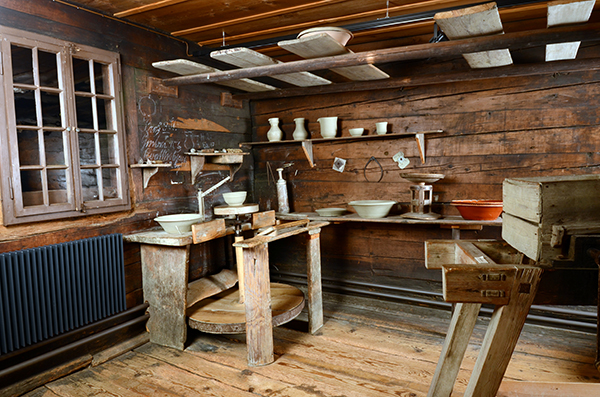
Reproduction of a potter’s workstation at the Langnau Regional Museum, with original objects from the Röthlisberger pottery.
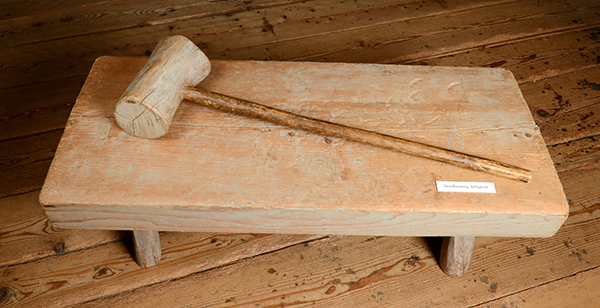
Workshop of Johann Röthlisberger (1876–1942), Langnau. Bench and mallet for pounding lumps of clay as part of the preparation process.
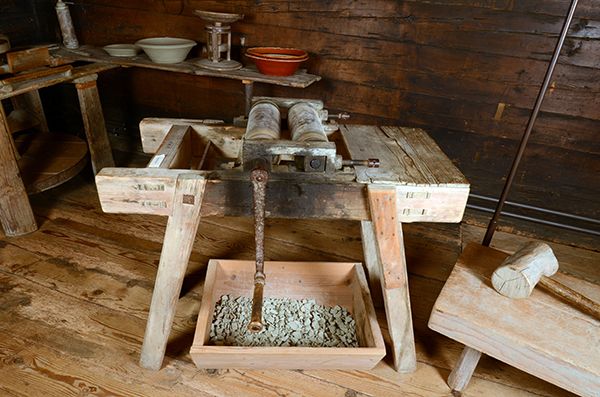
Workshop of Johann Röthlisberger (1876–1942, Langnau). Clay crusher used in clay preparation, now in the Langnau Regional Museum.
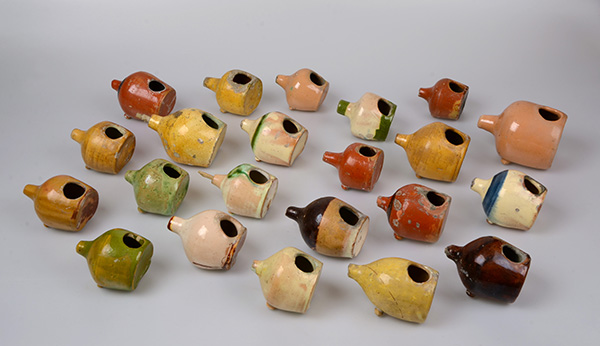
Workshop of Johann Röthlisberger (1876–1942), Langnau. Slip trailing cups from the pottery.
After pottery production ceased (the last pieces were fired in 1953) but before the property was sold (in 1961), Fritz Brechbühl donated to the Langnau Regional Museum various items from the workshop, including a potter’s wheel, a clay crusher, a clay bench, various plaster of Paris moulds for the production of crockery and animal figures and a number of slip trailing cups, all of which were used to create a reproduction of a potter’s workshop. Other plaster and ceramic moulds for making animal figures, handles or kiln furniture, passed into private ownership.
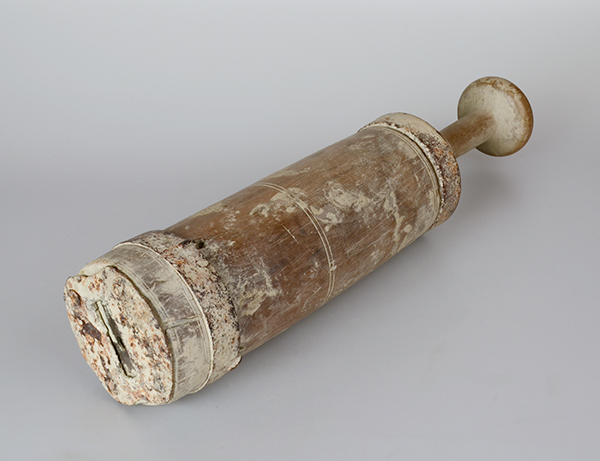
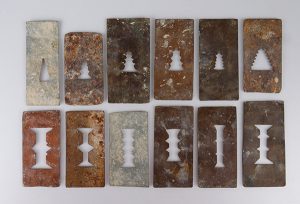
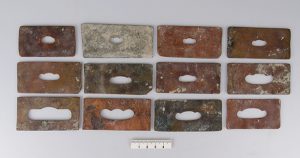
Workshop of Johann Röthlisberger (1876–1942), Langnau. Particularly worth mentioning is a wooden handle extruder with dies to make handles and kiln furniture. The original is now in the Langnau Regional Museum, the dies are in private ownership.
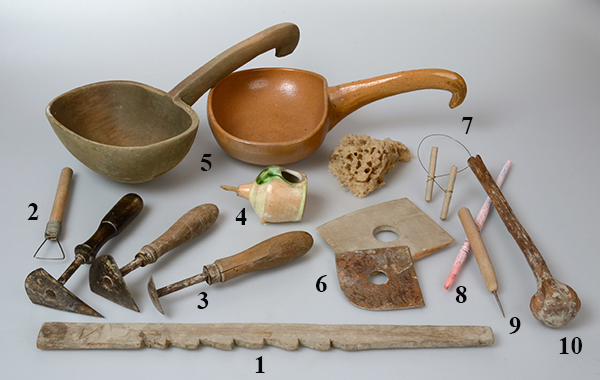
Workshop of Johann Röthlisberger (1876–1942), Langnau. Various tools and implements: (1) a throwing gauge (tally stick), (2) clay loop, (3) trimming tools, (4) slip trailer, (5) wooden and ceramic ladles for pouring slip or glaze, (6) wooden and metal potter’s ribs, (7) cut-off wire, (8) brush, (9) incising tool and (10) wooden stick with ball end for shaping rounded vessel walls.
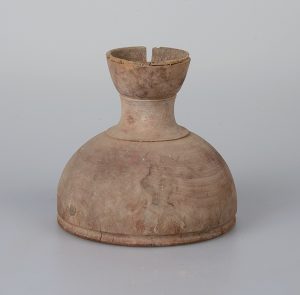
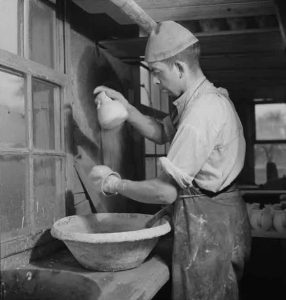
Workshop of Johann Röthlisberger (1876–1942), Langnau. Turned pouncer for adding finely ground powdered glaze or lead oxide (so-called “dry glazing”. Working scene: Hänni pottery, Heimberg 1946; StAB FN_Hesse_249).
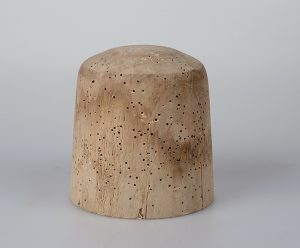
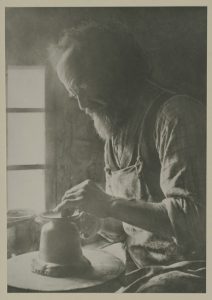
Workshop of Johann Röthlisberger (1876–1942), Langnau. Wooden “hump”, a pedestal used for throwing small objects. Working scene: workshop of Jakob Reusser (1853-1944), Heimberg, 2 Schulgässli (Stauder 1917).
In addition, Christian Wüthrich was able to secure a number of objects before the workshop was demolished, including tools, numerous ceramics made by the Röthlisberger pottery and written documents and pottery designs by Paul Wyss (1875–1952), the Bernese arts and crafts instructor.
The products made by the Röthlisberger pottery
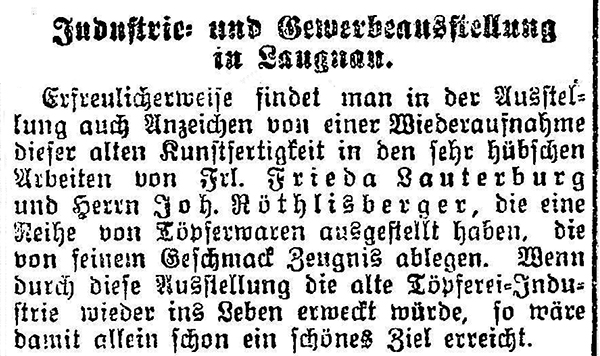
Der BUND newspaper 4/7/1907, excerpt.
The earliest surviving documentary evidence pertaining to the Röthlisberger pottery is a newspaper report in Der BUND (4/7/1907) dating from a relatively late period in the workshop’s history. There are no entries in the Swiss Official Gazette of Commerce. We know from the newspaper report that both Frieda Lauterburg and Johann Röthlisberger exhibited modern ceramic wares at the 1907 industrial and trade exhibition in Langnau, which were quite well received. The events that occurred between then and the outbreak of the First World War were probably closely connected with this exhibition and the subsequent endeavours of the Bern Museum of Applied Arts to support the local pottery industry in Heimberg/Steffisburg and Langnau by offering training and by supplying templates. The main driving forces behind all these activities were Paul Wyss, arts and crafts instructor in Bern since 1900 and his boss Oscar Blom (Director of the Bern Museum of Applied Arts, 1890-1924; Messerli 2017, 58). Paul Wyss tried to attract the interest of potters by giving lectures on the subject and initially focused on the Heimberg-Steffisburg region (Wyss 1906). One of the direct results was the founding of the School of Drawing and Modelling in Steffisburg in 1906. Oscar Blom personally described these endeavours and activities of the Museum of Arts and Crafts in Bern in 1908. At that time there was no mention made of Langnau.
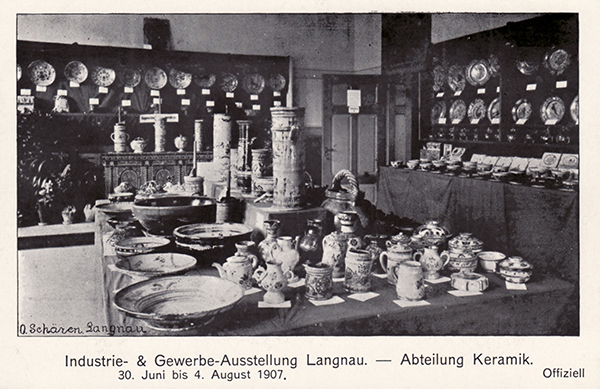
This changed on 12th and 13th August 1909, when both the Intelligenzblatt der Stadt Bern and the Oberländer Tagblatt published the same report: “The Langnau Association of Trades and Crafts is making an effort to reintroduce the old style of Langnau pottery, which was part of a successful exhibition at the last trade fair in the district of Signau [1907, see postcard above].” It is not clear where this information came from, and the municipal archive does not appear to hold any documents pertaining to the Langnau Association of Trades and Crafts; what we do know is that the association was the main sponsor and organiser of the 1907 trade fair. On 15th October 1909, Paul Wyss gave a lecture on the revival of Langnau pottery as part of a public meeting (Der BUND 1/10/1909). Wyss was personally very familiar with the situation in Langnau, as he had grown up there from 1885 onwards, and in 1900, had married Hanna Müller, the eldest daughter of the pastor in Langnau. Resulting from the public meeting, a commission was established (by the Association of Trades and Crafts?) which aimed “to revive the Langnau pottery industry” and which, after several meetings with the master potters who were still working in Langnau (probably six workshops) decided to offer a long-term drawing and decorating course at the Langnau Vocational School. The first course began on 12th November 1909 and was run by Paul Wyss (Der BUND 13/11/1909; Oberländer Tagblatt 17/11/1909). Classes were held on Friday afternoons from 1pm to 6pm. The plan was that the course participants would later produce the objects they had designed on paper (Der BUND 19/8/1910; NZZ 23/8/1910; Intelligenzblatt der Stadt Bern 25/8/1910).
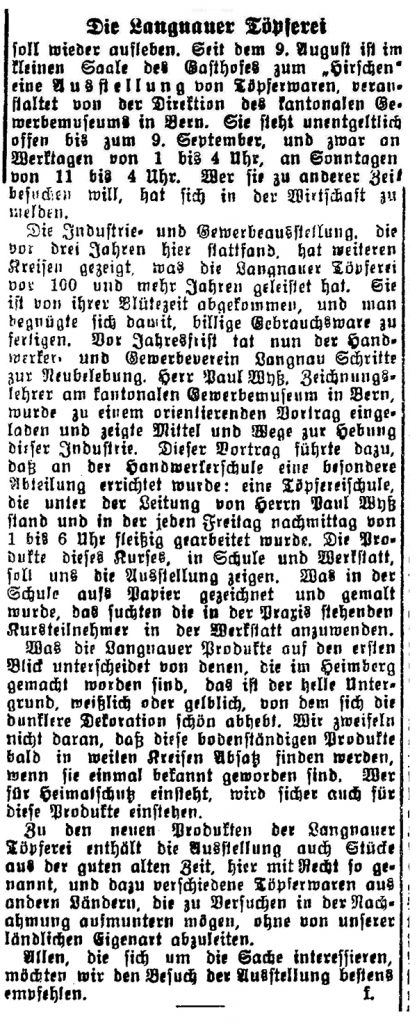
Der BUND 19/8/1910.
The first designs from the course were presented in an exhibition curated by the Bern Museum of Arts and Crafts in the small function room of the Restaurant zum Hirschen in Langnau from 9th August to 9th September 1910 (Der BUND 19/8/1910; also NZZ 23/8/1910; Intelligenzblatt für die Stadt Bern 25/8/1910). A short biographical essay published to celebrate Paul Wyss’s 60th birthday, explicitly stated that his classes were being attended by potters from Langnau, Schüpbach, Grünenmatt and Oberburg (Die Berner Woche 25, 1935, 947; Messerli 2017, 93). Unfortunately, the piece did not mention any names, but based on later contacts and products, we can presume that they included workers, apprentices, journeymen and master potters from the Gerber workshop in Hasle, the Gerber workshop in Sumiswald-Grünen (?), the Gerber-Kohler workshop in Schüpbach, and the Mosimann, Röthlisberger, Aegerter and Werthmüller workshops in Langnau.
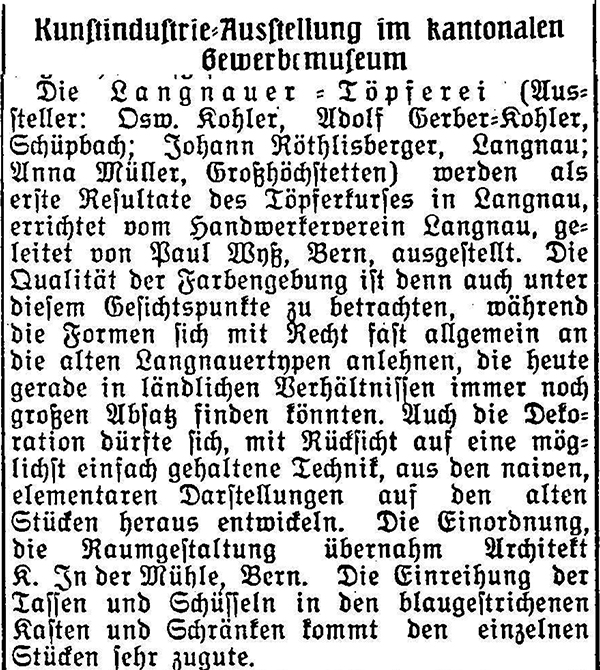
Der BUND 18/1/1911, excerpt.
The assumption is at least partially confirmed by another newspaper report dated 18th January 1911 (Der BUND). A detailed review of an arts and crafts exhibition at the Museum of Applied Arts in Bern also mentioned new potters’ workshops in Langnau. The exhibitors referred to by name were Oswald Kohler and Adolf Gerber-Kohler (Schüpach), Johann Röthlisberger (Langnau) and Anna Müller (Grosshöchstetten).
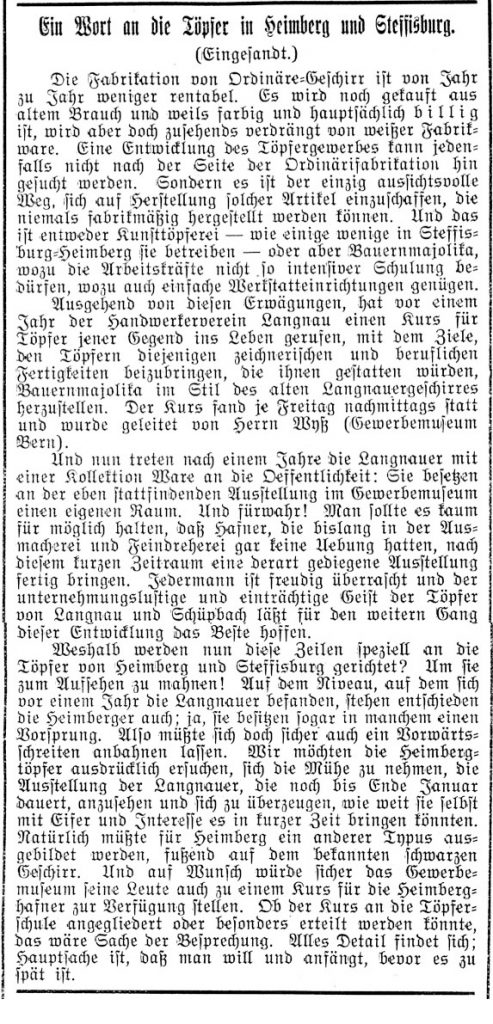
Geschäftsblatt des oberen Teils des Kantons Bern 57 No 103 dated 24th December 1910 in reference to the Christmas Exhibition at the Museum of Applied Arts in Bern.
Members of the press reacted quite favourably and were surprised by what they witnessed at the exhibition, and on 24th December 1910, it was held up to the Heimberg potters as an example of how the craft could be developed: “It is quite remarkable that potters with no previous experience in pottery painting and throwing fine shapes, have already managed to produce such a tasteful exhibition after such a short period of time. Everyone has been pleasantly surprised and the enterprising and amiable spirit of the potters of Langnau and Schüpbach has instilled great hope for the future development of this craft.”
The documents and ceramics that have survived from the Röthlisberger workshop include easily recognisable witnesses to the events described, although the lack of signatures on many of the designs and drawings makes it difficult to ascertain whether they were made by the apprentice, Fritz Brechbühl (1893-1954, apprenticeship 1910-1913), or by Johann Röthlisberger (1876–1942) himself.
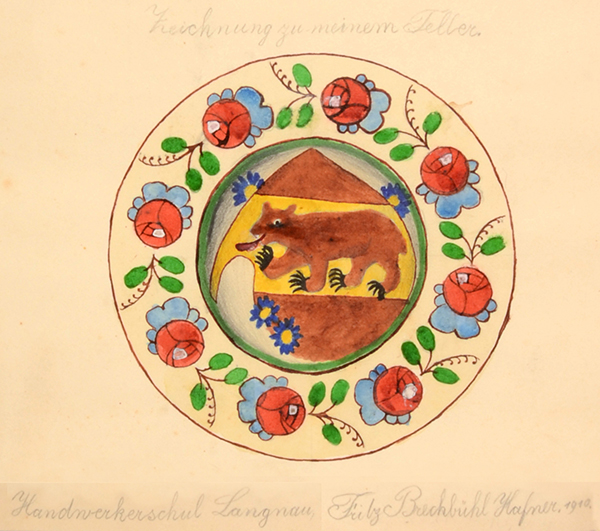
Two of the ceramic designs have Fritz Brechbühl’s signature; one is dated 1910, the other 1912.
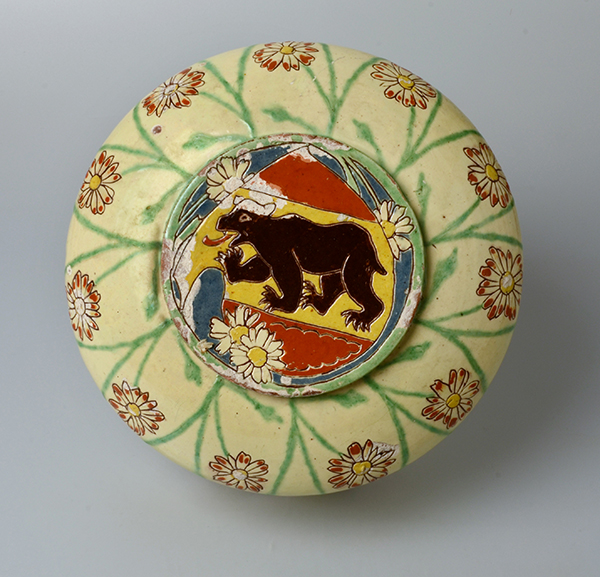
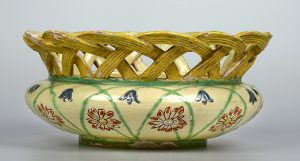
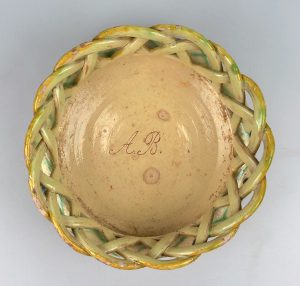
The coat of arms design in the middle of the first sketch was obviously used later, either by himself or by another potter at the Röthlisberger workshop, to make a basket which is signed on the inside with the mark “A.B.”. We can only assume that these initials stand for “Anna Brechbühl”.
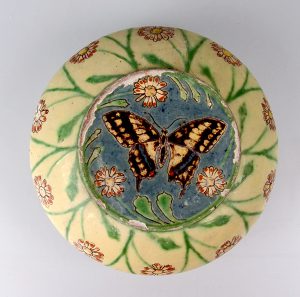
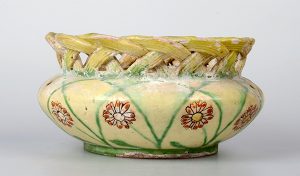
A very similar vessel has a depiction of a butterfly on its base.
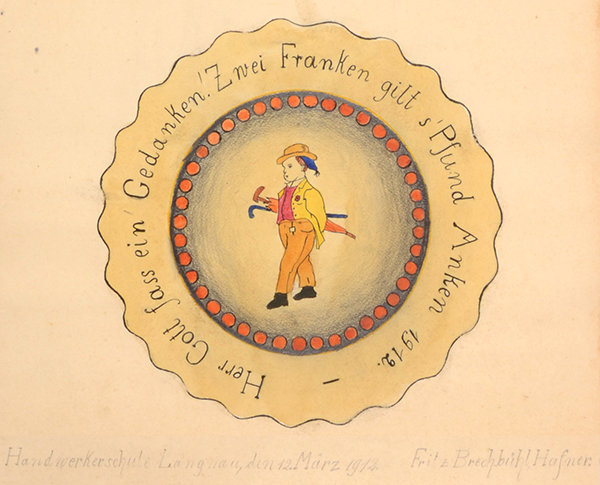
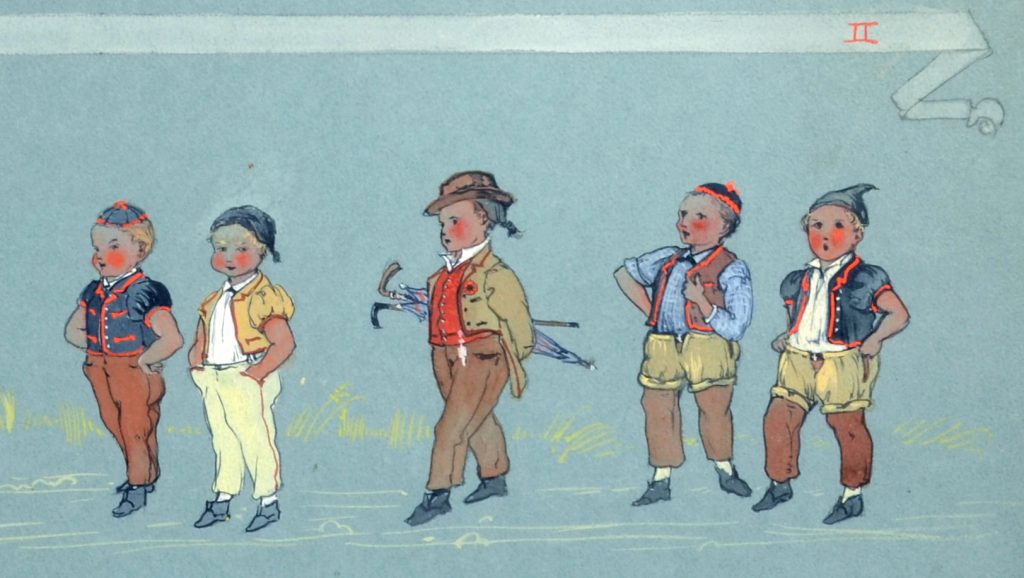
The other motif was clearly modelled on Paul Wyss’s draft sketches for the children’s parade at the Langnau marksmen’s festival in 1906
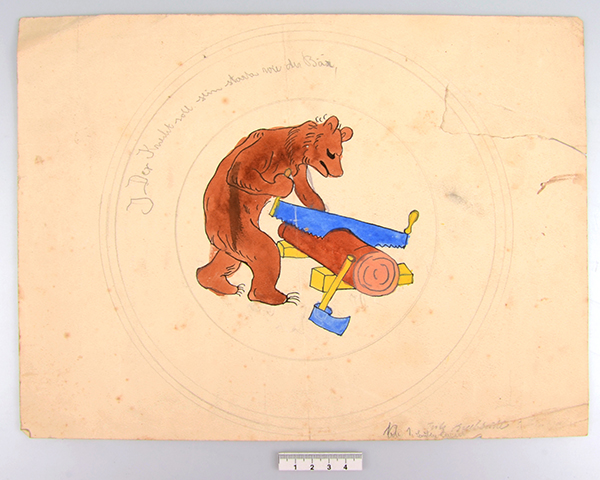
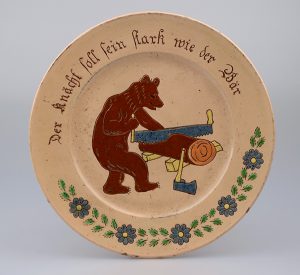
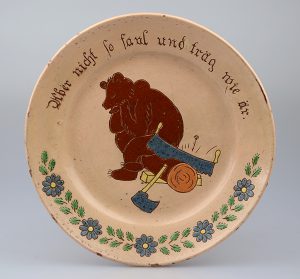
Another signed sketch shows a bear in the style of Paul Wyss or Karl Gehri (1850-1922). It later appeared on a plate, which seems to have been one in a “series on bears”.
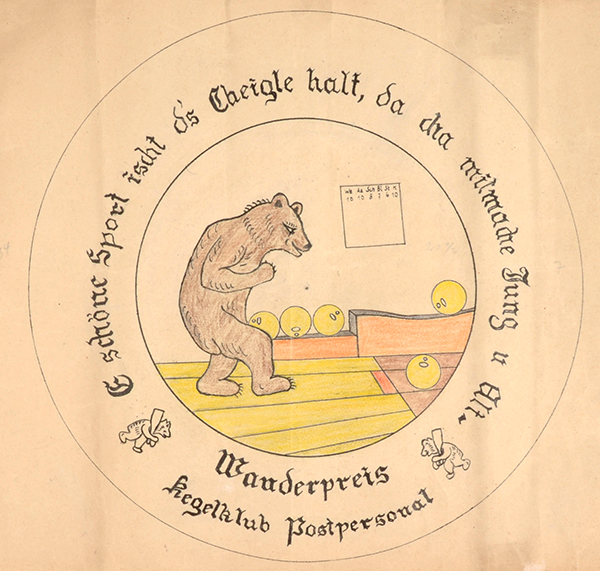
Bearing in mind that Fritz Brechbühl later became a postman, we can probably also attribute a later draft sketch for the “Postal Staff Bowling Club Challenge Trophy” to him.
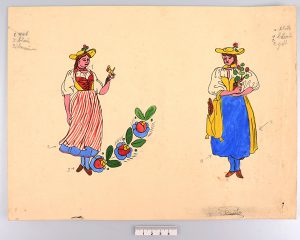
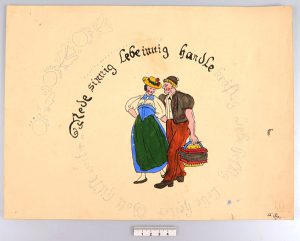
Two other designs signed by Fritz Brechbühl show women or couples in traditional Bernese costume which would have been framed by mottos and used as the central motifs on plates and shallow dishes similar to those found on objects made by both Johann Röthlisberger and Adolf Gerber.
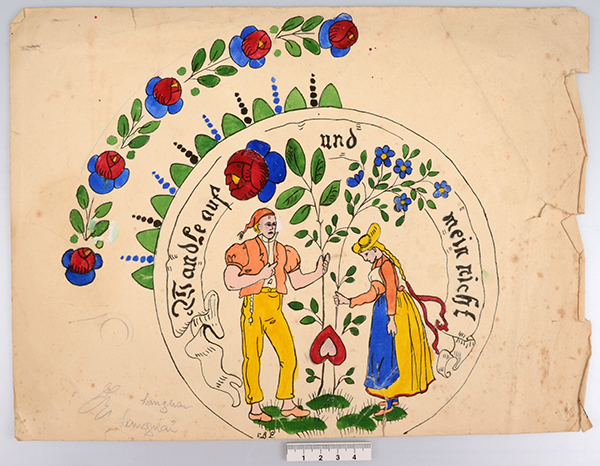
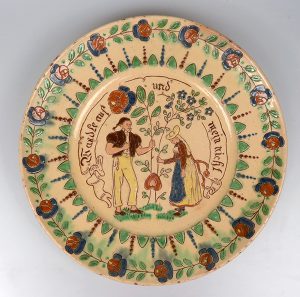
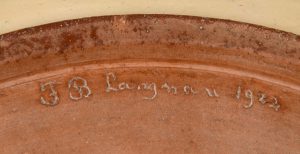
Surprisingly, another one of Fritz Brechbühl’s designs was not used to produce an actual ceramic object until 1922, as confirmed by his own signature
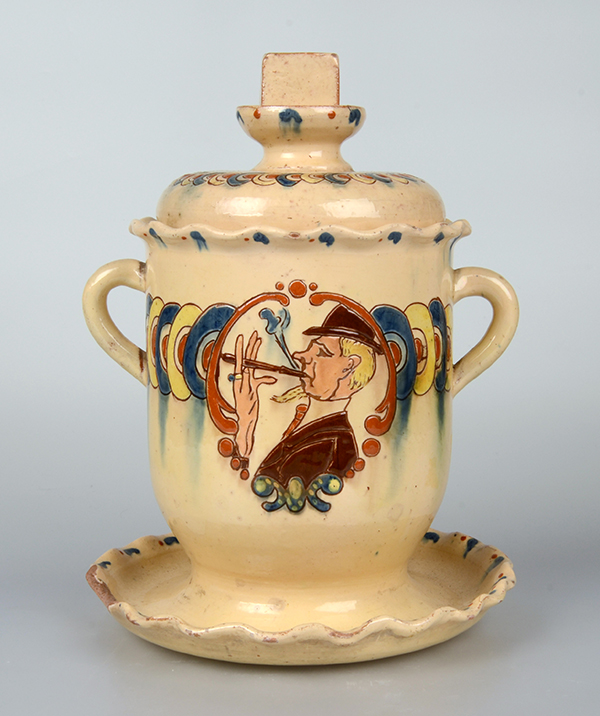
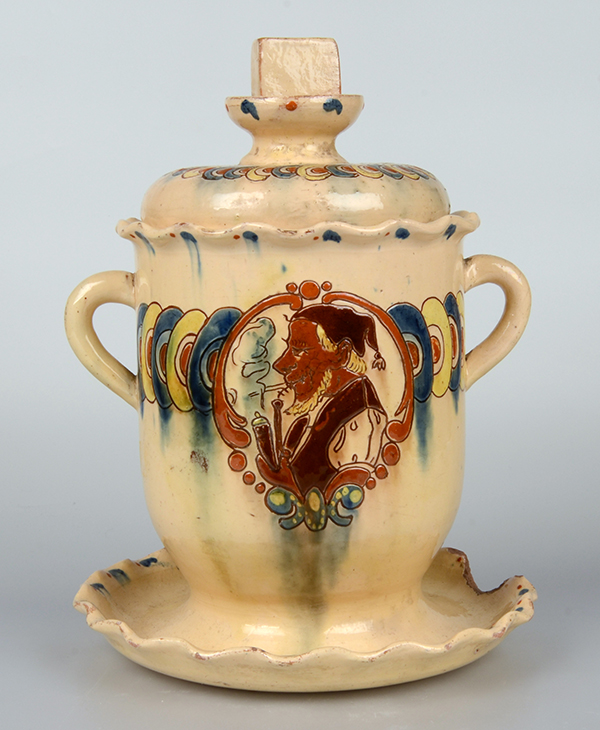
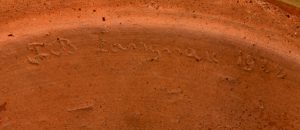
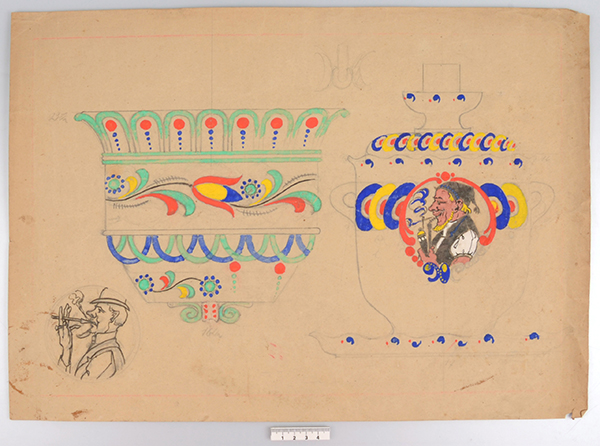
The same can be said for an unusual tobacco jar, whose draft design was found among a series of unsigned sheets from a drawing class. We can probably assume that these were the sketches the students were instructed to drawn in class. We also have the course materials from another such drawing class taught by Paul Wyss and Ernst Frank. Unfortunately, it is not clear who made the drawing of the two smokers, but Paul Wyss is the most likely candidate.
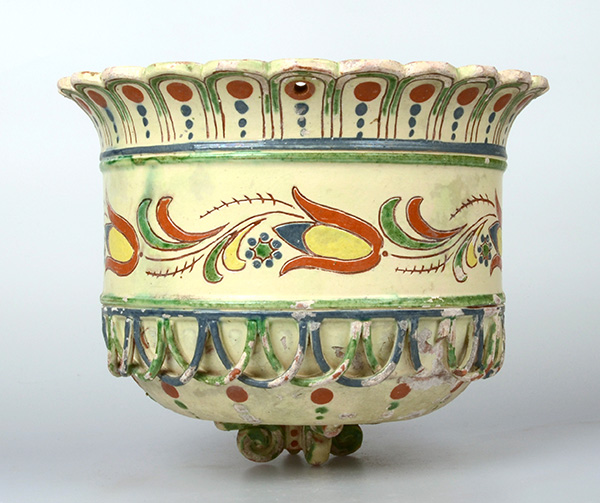
The hanging flowerpot in the drawing was obviously turned into an actual vessel.
A series of ceramics dated and signed with the initials “JR” can be attributed to master potter Johannes Röthlisberger. It is probably no coincidence that the series of dated pieces begins with the year 1910.
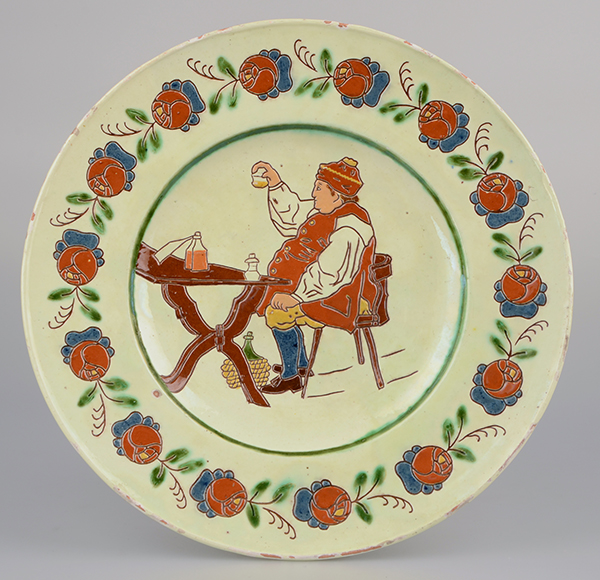
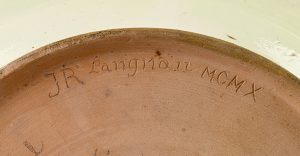
Two different plates have survived that bear the motif of the “Doctor of the Alps”, Micheli Schüppach from Langnau. The depiction was inspired by a well-known engraving entitled “Pharmacie rustique, nach der Natur gezeichnet von G. Locher und graviert von Bartholomäus Hübner, 1775” [painted from nature by G. Locher and engraved by Bartholomäus Hübner, 1775]. The scene was also later replicated by Adolf Gerber.
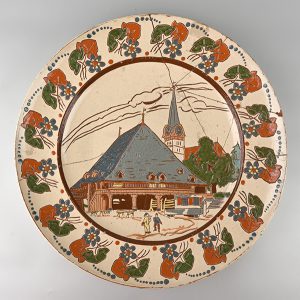
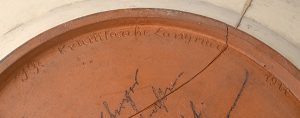
A plate with the depiction of the old market arcade in Langnau (built in 1519, demolished in 1900) was made in 1911 and is a record of the sad loss of an important architectural monument. Adolf Gerber later also made numerous plates with the same motif. Apparently, it was not difficult to copy the motifs and templates.
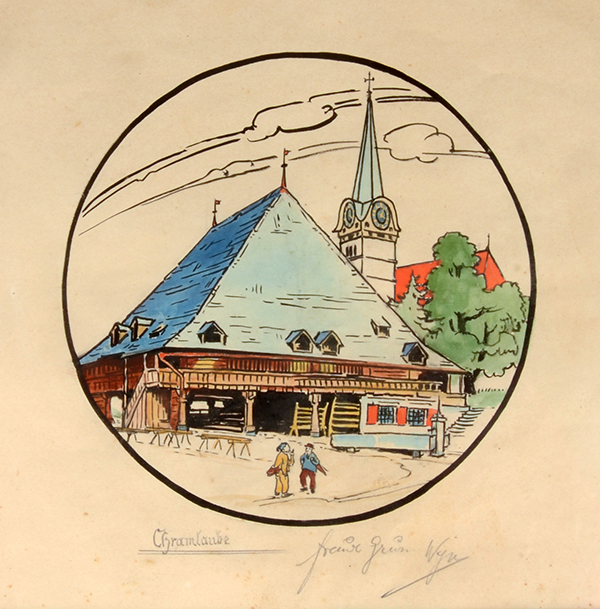
Paul Wyss’s preparatory drawing may have been modelled on an earlier photograph. The same template was reused in 1926.
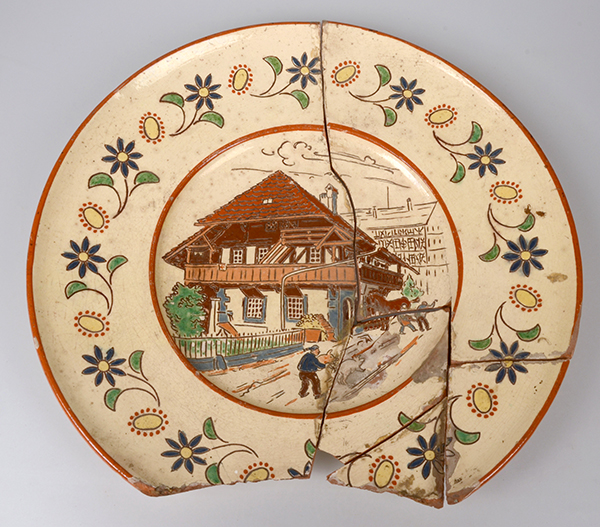
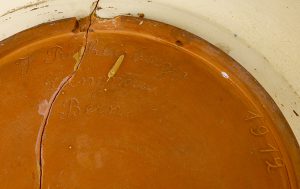
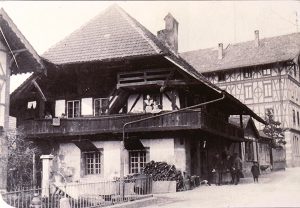
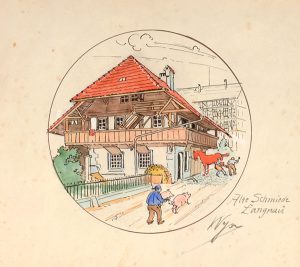
Finally, in 1912, a plate was made with a depiction of an old smithy in Langnau (since demolished), which was also modelled on a template by Paul Wyss. In 1937, Johann Röthlisberger used the same motif again.
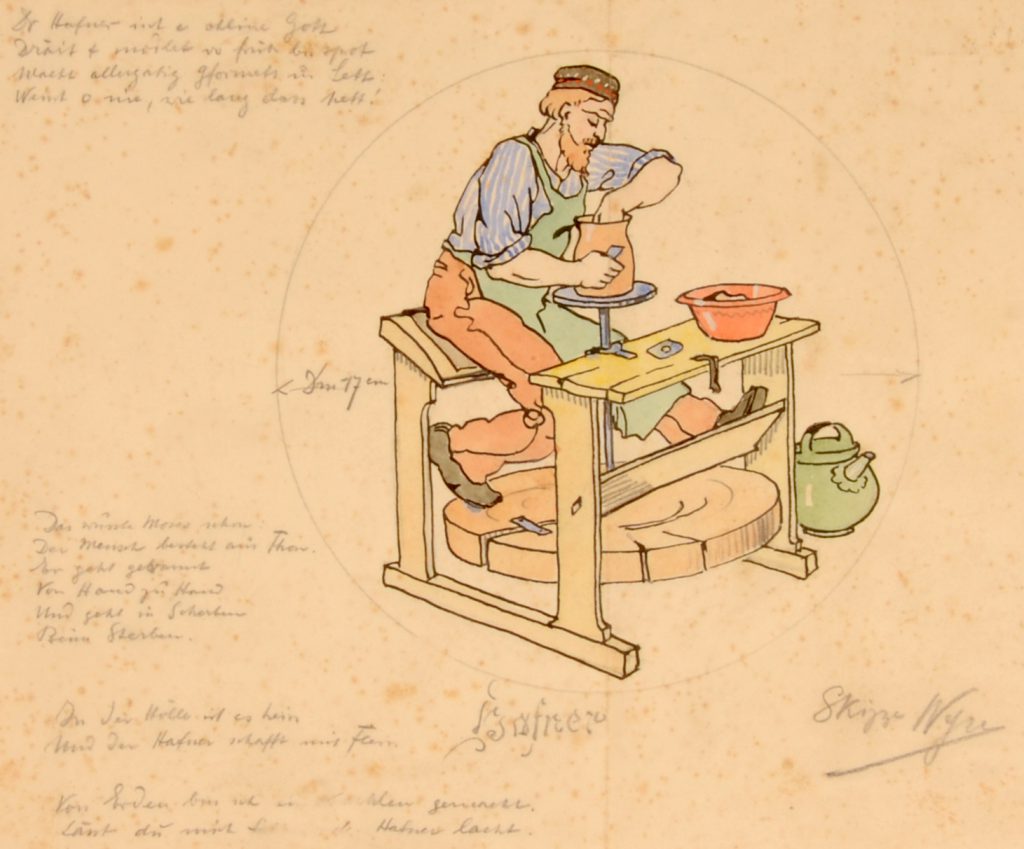
The collaboration with Paul Wyss must have been very close at that time, as the archive contains further draft sketches, most notably an impressive drawing of a potter working at a kick wheel with a rotating axle. Based on known images of the different family members, the potter depicted here could be Friedrich Röthlisberger (1846–1920) (see above).
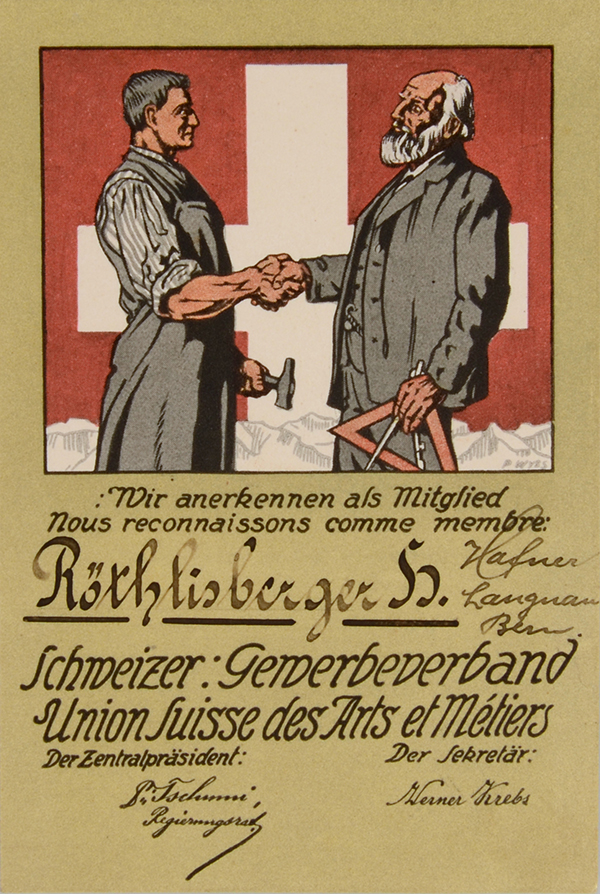
This was probably also the period during which Johann Röthlisberger joined the Swiss Union of Arts and Crafts (membership certificate designed by Paul Wyss).
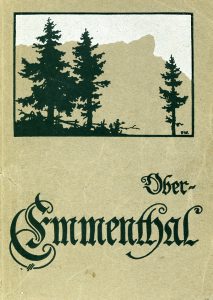
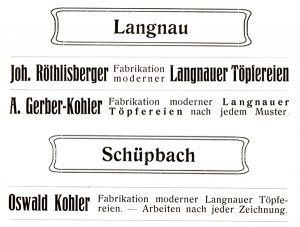
A brochure published by the Langnau tourist office in 1913 contains an advertisement for “Joh. Röthlisberger – Production of modern Langnau wares”. Also in the brochure are advertisements for Adolf Gerber-Kohler (Langnau) and his brother-in-law, Oswald Kohler (Schüpbach).
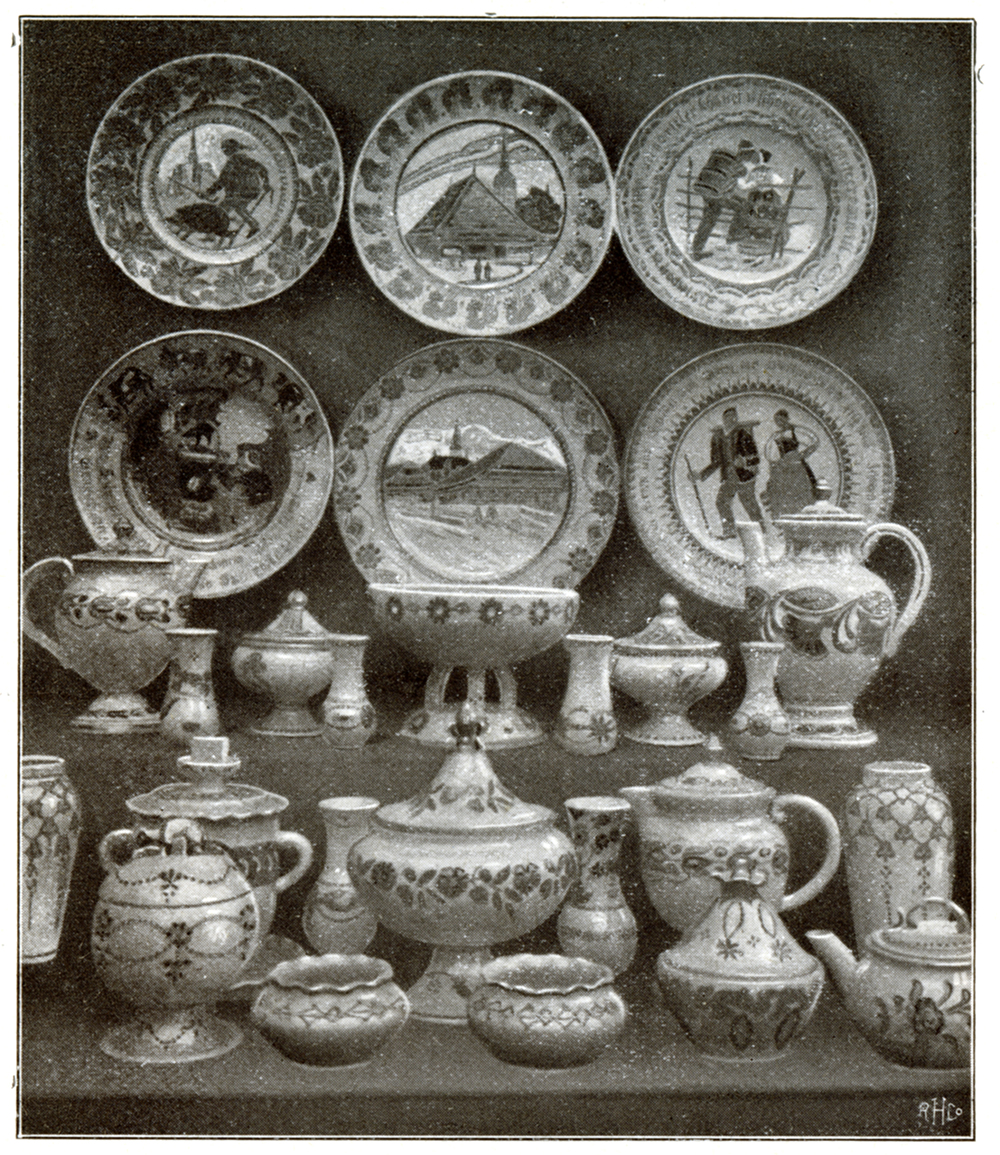
Pottery from the Röthlisberger workshop, 1913.
More importantly, however, the brochure also contains an illustration, which includes large decorative plates that can now be attributed beyond doubt to the Röthlisberger workshop based on the sketches that have survived and the course materials from the drawing class mentioned above.
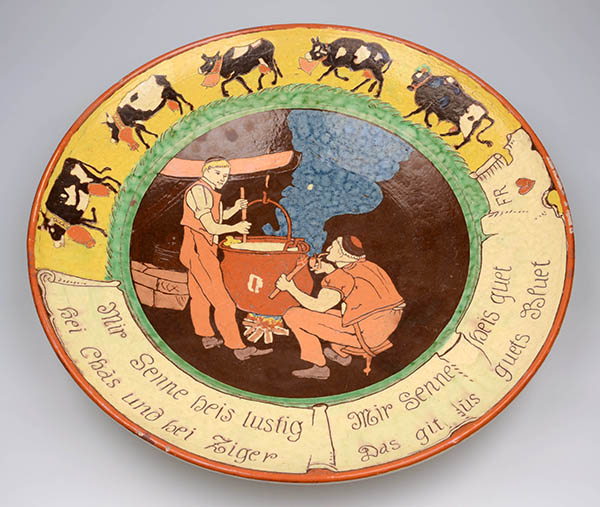
The market arcade has already been mentioned (above); a plate with a depiction of cheesemakers (bottom row on the left) has survived at the Bern School of Design (SfGB 061). It bears the signature “Fritz Röthlisberger Langnau” on the reverse and the initials “FR” (Friedrich Röthlisberger, father or son) with a heart containing the letter “L”, probably for Langnau, on the front right.
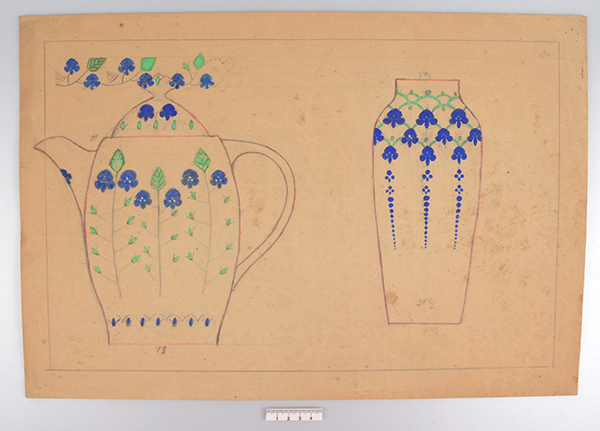
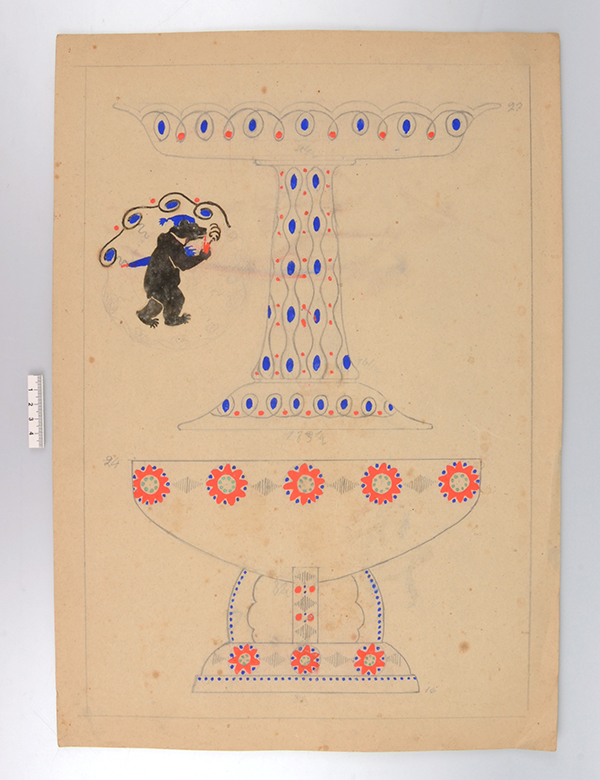
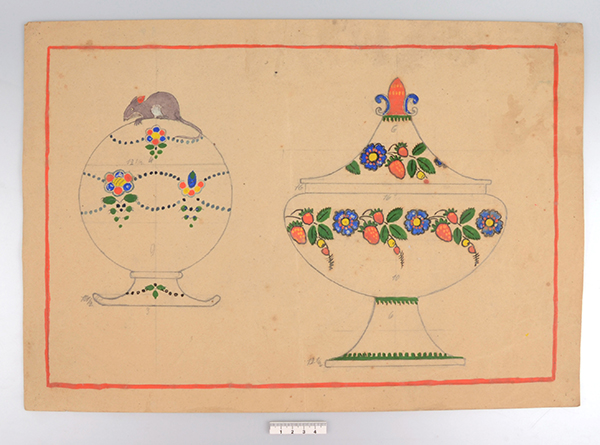
Numerous designs from the drawing class can also be found in the illustration.
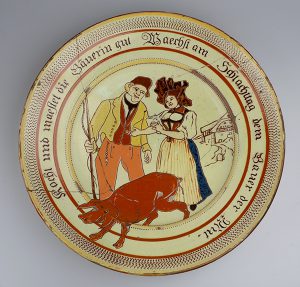
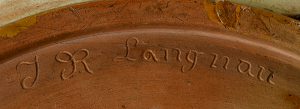
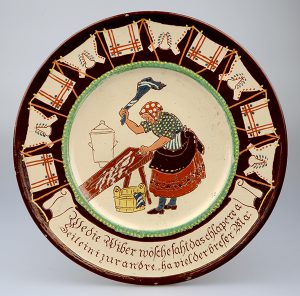
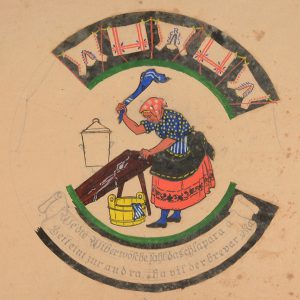
Three other vessels can clearly be attributed to the Röthlisberger workshop based on signatures and templates or draft sketches. The two plates correspond very well to the typical range of shapes and decorations.
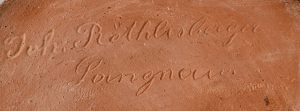
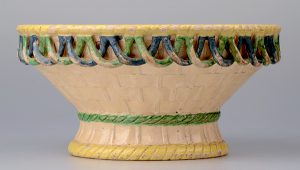
The bowl, on the other hand, is an unusual piece, which appears to have been made by pressing the clay into a plaster mould. This produced a relief that gave the impression of basketry. Similar baskets had already been made in the earlier period of Langnau pottery production (Heege/Kistler 2017, 652 Fig. 782).
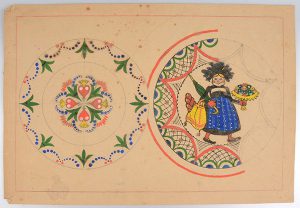
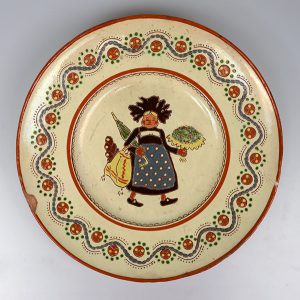
Another unsigned plate in private ownership, for which we have a draft design, was probably also made by the Röthlisberger workshop.
In 1914, Johann Röthlisberger took part in a collective exhibition of Langnau potters which was held at the Swiss National Exhibition in Bern (Hermanns 1914, 377).
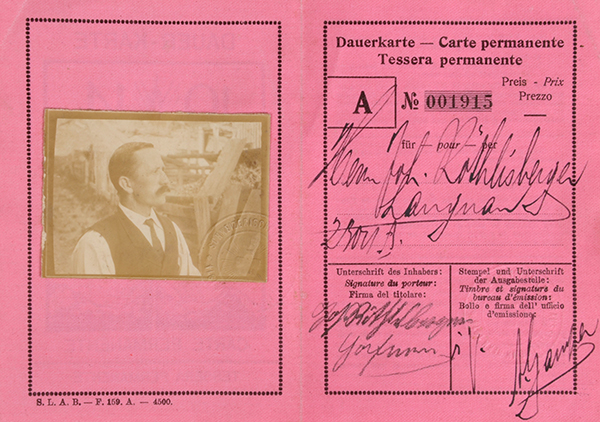
His ticket gave him free admission for the duration of the exhibition.
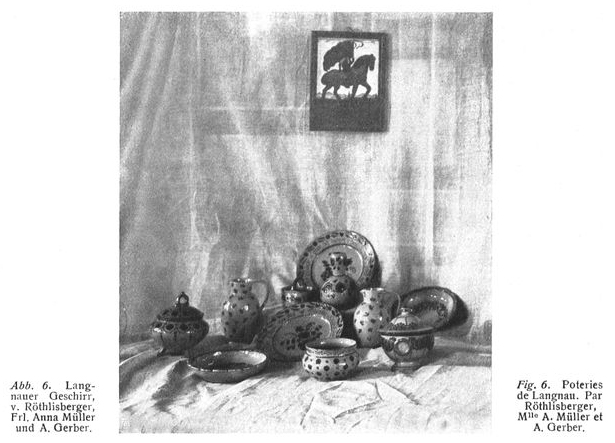
A report on the “Dörfli” [village] Bazaar published in 1914 included a photo which showed pottery made by Johann Röthlisberger, Adolf Gerber and Anna Müller (Conradin 1914, Fig. 6).
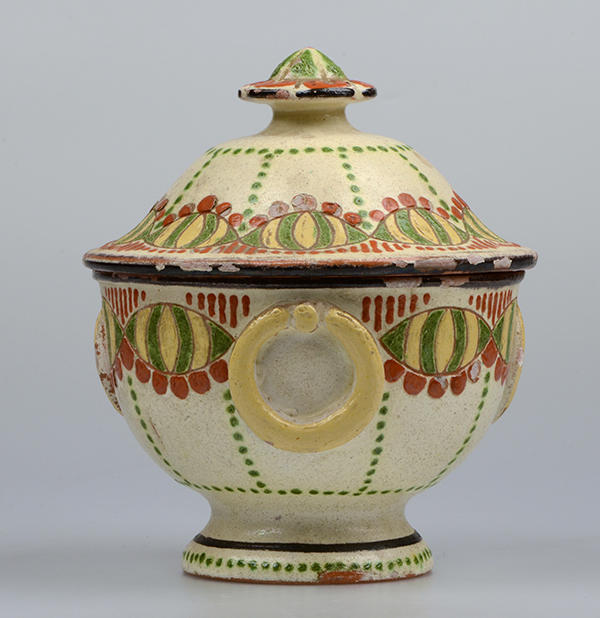
A tureen very similar to the one on the front right of the photo has survived in a private collection in Langnau. Der BUND newspaper (9/10/1914) described the joint exhibition as follows: “Once famous and now enjoying renewed appeal, Langnau pottery is represented by a collective exhibition of potters and various private exhibitors …; ordinary everyday wares alongside elegant and modern Langnau studio pottery, including hanging plates, coats of arms and jugs etc. that are particularly noteworthy thanks to the comical mottos and delightfully colourful pastoral scenes they are decorated with.”
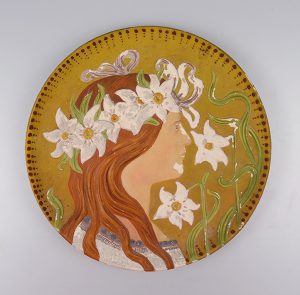
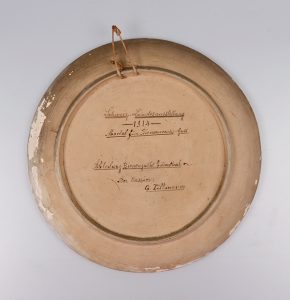
Johann Röthlisberger also made moulds for casting beeswax for the department “Emmenthal valley apiculture”
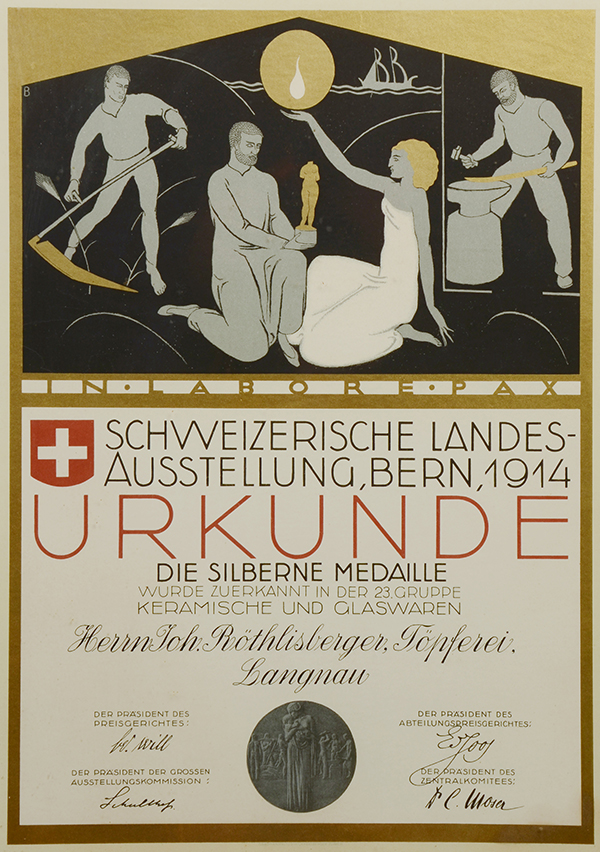
His participation in the National Exhibition in Bern earned him a silver medal.
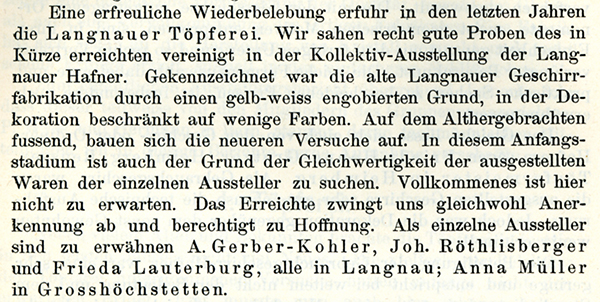
Expert report on Group 23 at the 1914 Swiss National Exhibition, Pottery and Glass, Kiefer 1914, 74, excerpt.
The report from the jury panel (Kiefer 1914, 74) was very complimentary on what had already been achieved and stated that there was good reason to be hopeful for more positive developments to come. In its report on the exhibition, the NZZ newspaper (29/10/1914) expressed its hope that in the future, “the patterns will be kept as simple as possible, and the colours will remain clear and definitive.” This, they believed, would benefit local art the most.
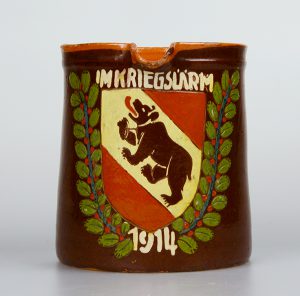
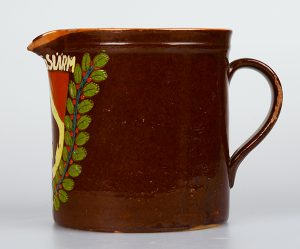
The outbreak of the First World War appears to have at least partially thwarted the hopeful new beginnings, as only a few ceramics have survived from the subsequent decades of Röthlisberger production that in terms of quality can be considered equal to the workshop’s earlier wares.
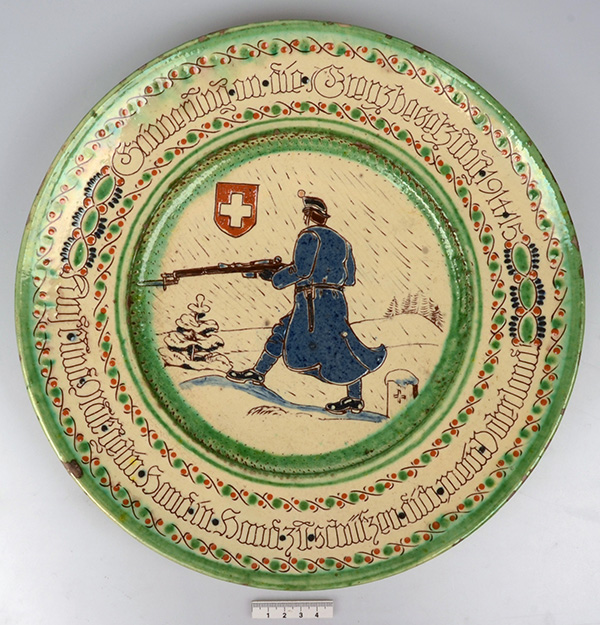
Only one unmarked plate from the period after 1915 (private ownership Langnau) which, based on its history of ownership, may have come from the Röthlisberger workshop, is more elaborate in design.
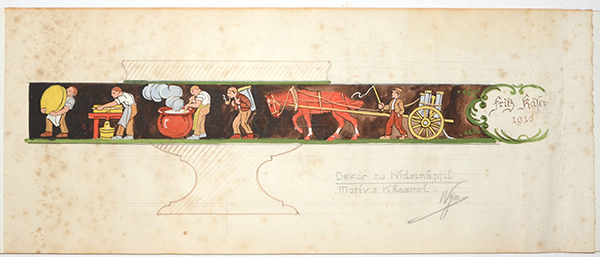
The archival materials included only one draft design by Paul Wyss that is dated 1916..
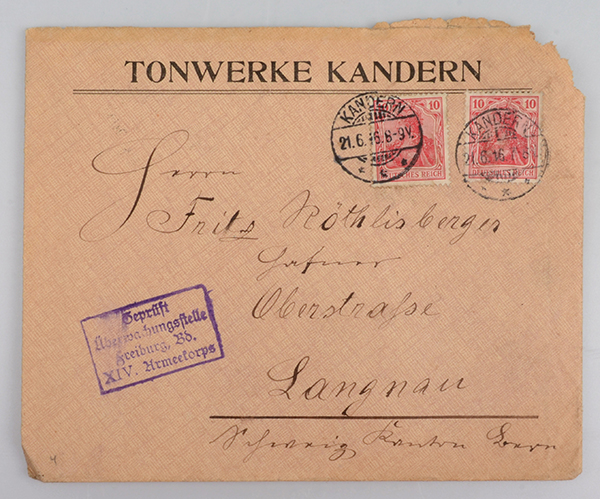
On 20th June 1916, the Tonwerke Kandern, a German pottery manufactory, got in touch with Johann Röthlisberger to ask if he would be interested in working for them as an “able freehand thrower” of luxury wares. Apparently, the offer did not appeal to him, as he remained in Langnau.
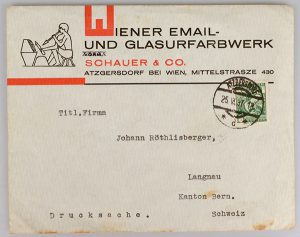
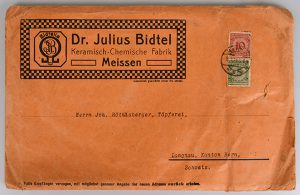
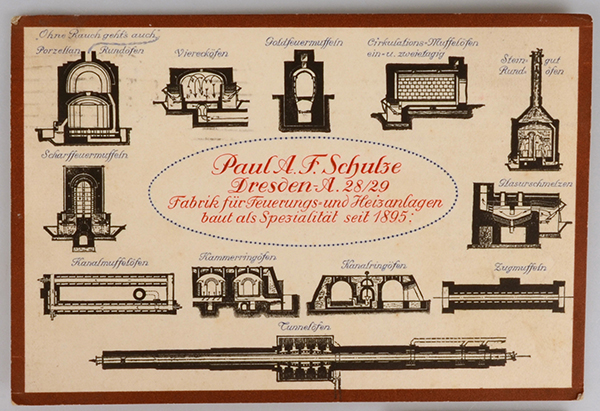
Other letters from the workshop’s business correspondence attest to contact in the 1920s and 1930s with Dresden, Meissen and Atzgersdorf near Vienna. The main topic of discussion was probably raw materials for glazes (only the envelopes have survived).
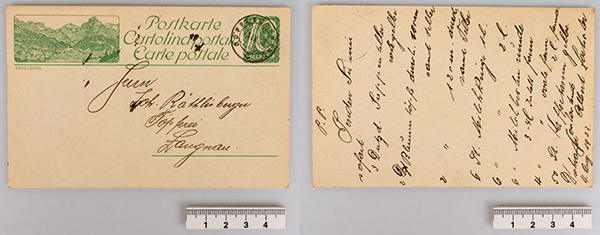
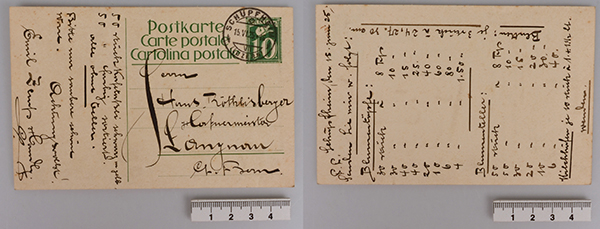
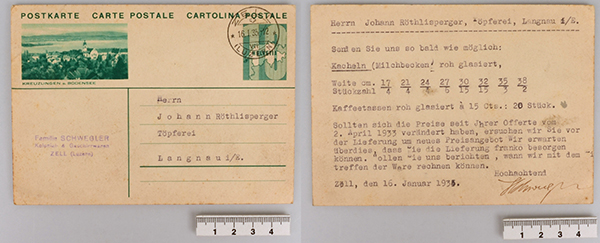
A series of postcards dating from the period between 1923 and 1935 show how both private customers and retailers/homeware shops, mostly from the Canton of Lucerne and from the surrounding areas of the Canton of Bern, tended to place their orders. Soup plates, flowerpots, milk jugs and coffee cups were ordered without any particular decorative patterns being specified. In some cases, the order volume was also mentioned. Buyers appear to have been mainly interested in value for money.
The next – and last – time the Röthlisberger workshop was mentioned in a newspaper was not until 1935 (Oberländer Tagblatt, 28/10/1935). This was to announce their participation in a “Chachelimärit” [crockery fair] at the Bern Museum of Applied Arts.
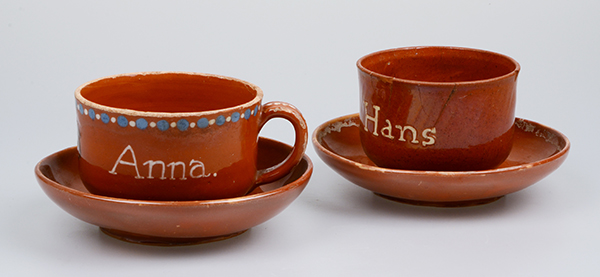
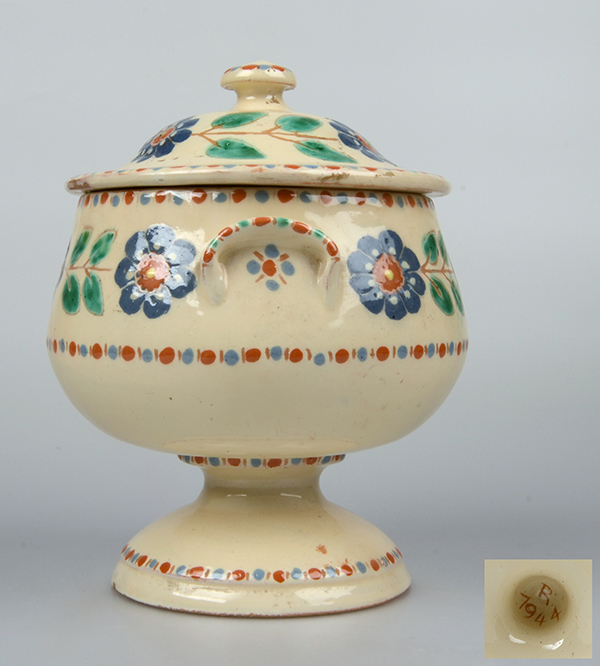
Wall plates decorated in the Paul Wyss style continued to be made by the Röthlisberger potters, as attested to by pieces dated 1926 and 1937, though the motifs used were the same as before. Other than that, only two further dated ceramics have survived: a pair of cups for “Anna and Hans” from 1936 and a lidded box with a pedestal foot from 1944. Like numerous other individual pieces, they were still in the workshop when the company was dissolved in 1953.
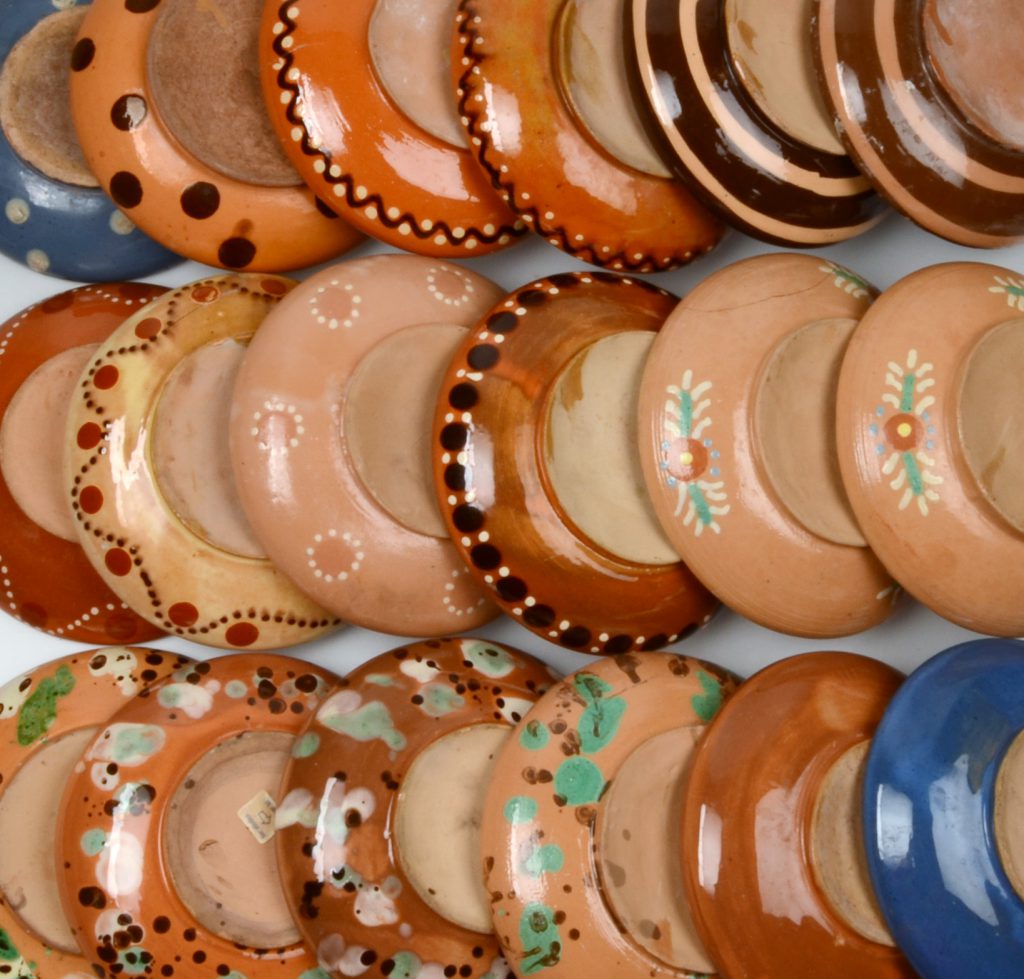
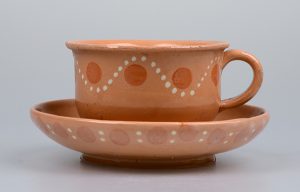
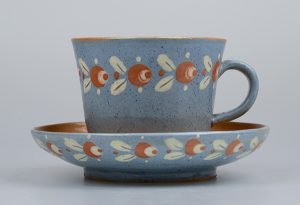
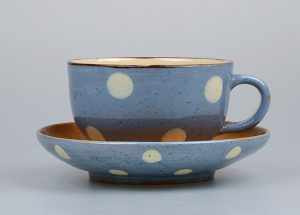
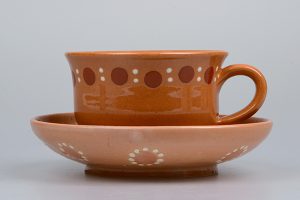
They were all that remained of the stock and had probably been made between approximately 1920/1930 and 1953, and included numerous cups and saucers with simple slip-trailed patterns and splashed decorations.
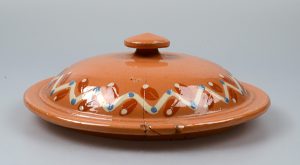
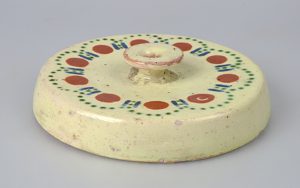
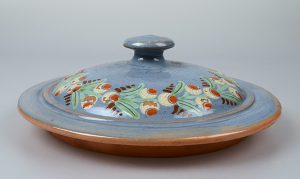
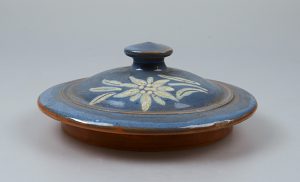
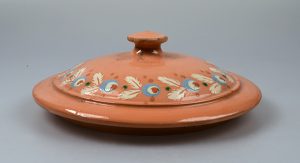
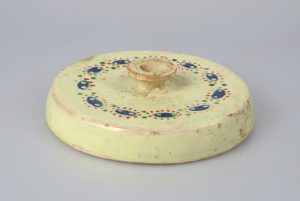
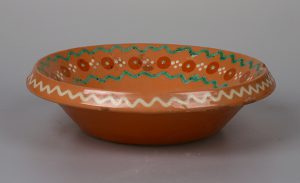
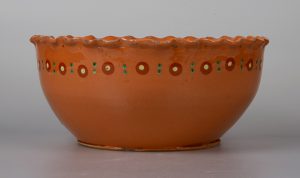
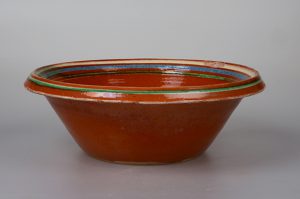
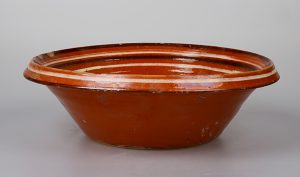
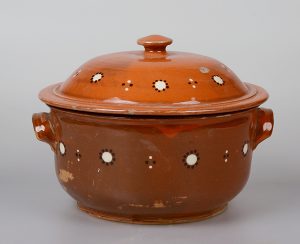
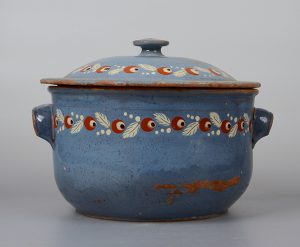
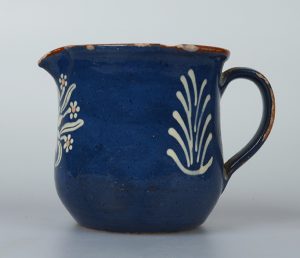
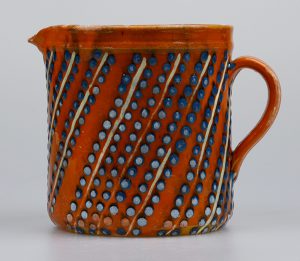
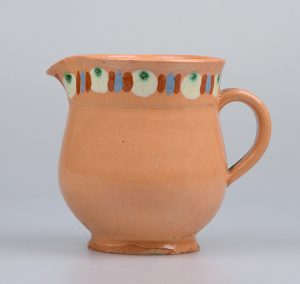
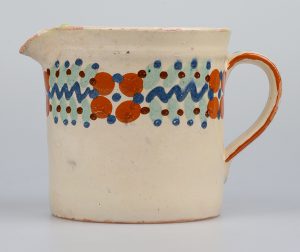
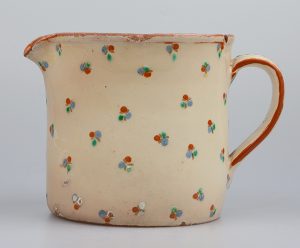
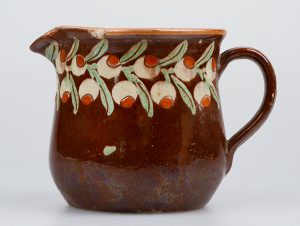
Other items were replacement lids, bowls, tureens and single-handled jugs (for milk). Remarkably, they also included pieces that were decorated with simple horizontal bands, which would actually have seemed rather outdated in the 1930s when they were made.
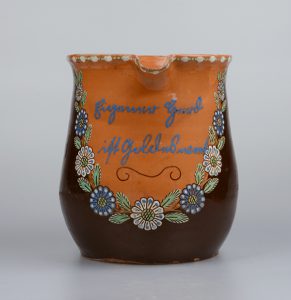
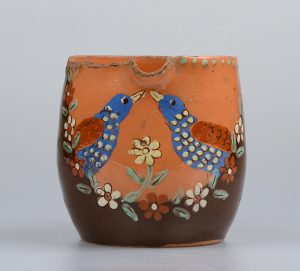
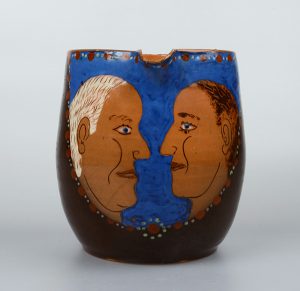
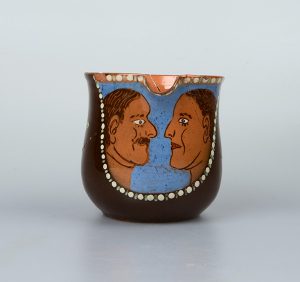
A group of small one-handled jugs stood out because of their unusual painted decorations.
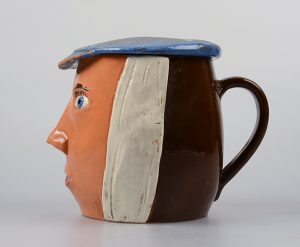
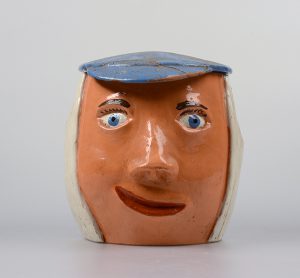
A lidded tankard was shaped like a face.
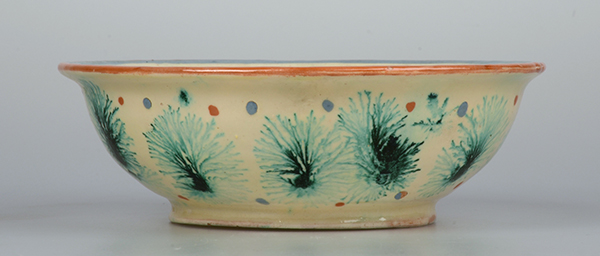
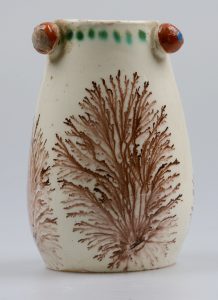
Another unusual feature was a small group of vessels with dendritic decoration, which could not, unfortunately, be dated precisely (on dendritic decoration see Heege 2019, 191-198).
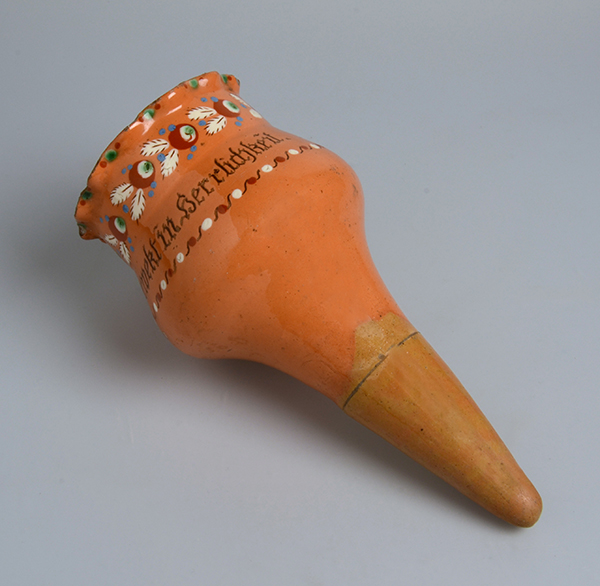
No ceramic grave vases (with spikes) have so far come to light from any other potters’ workshops in the Bern region. Similar pieces, however, can be found in the 1917 and 1919 pricelists of the Carl Bodmer & Cie pottery factory in the Canton of Zurich (Bodmer-Huber/Messerli 1986, Pls 17 and 22).
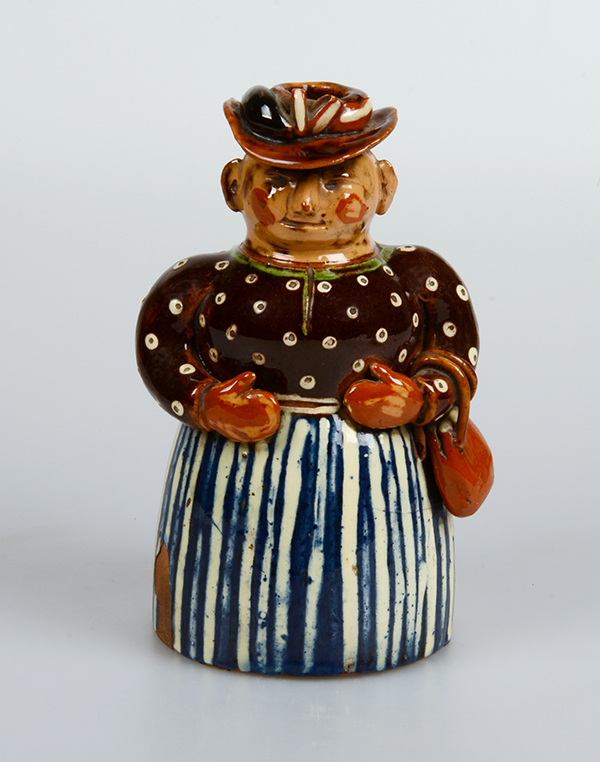
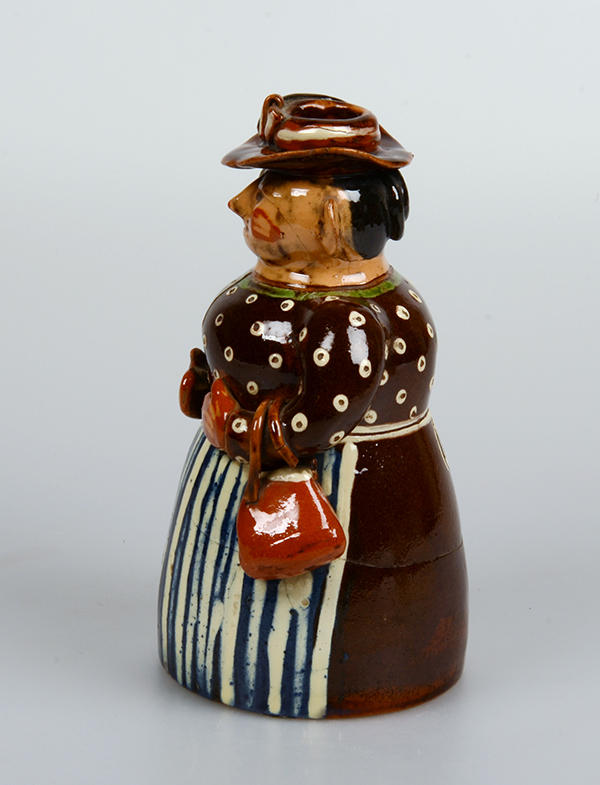
Relatively large figures, which could be used as candleholders, were also produced by the Röthlisberger pottery.
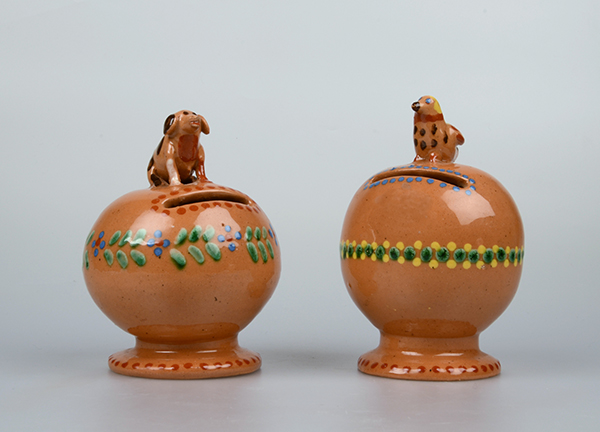
Money boxes with animal figurines on top were reminiscent of earlier examples from the Heimberg-Steffisburg region.
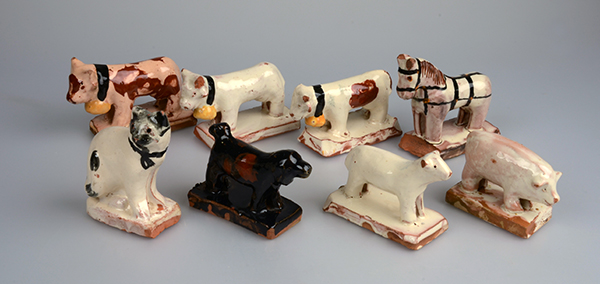
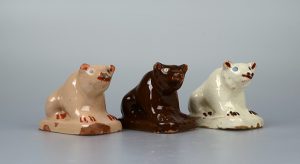
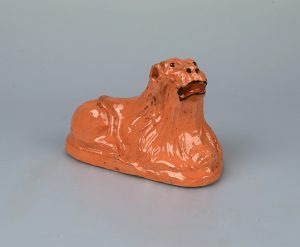
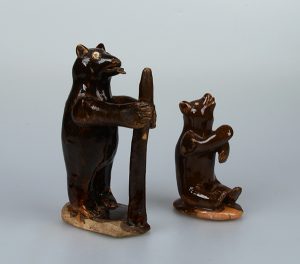
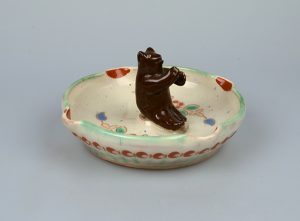
As well as many plaster moulds, the stock included finished objects such as cows, horses, cats, dogs, sheep, pigs, bears and lions. They are the same as those produced, for example, by the Kohler pottery in Schüpbach. Bears, sitting or standing, were also sometimes placed in the middle of an ashtray.
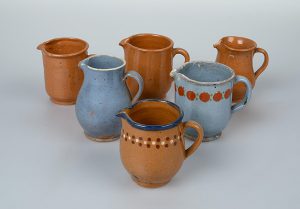
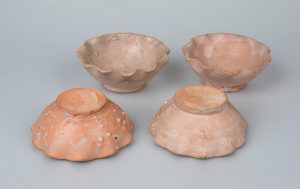
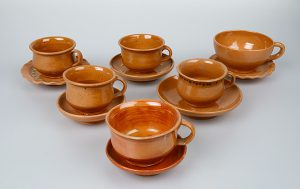
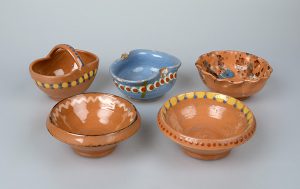
Numerous different miniature vessels for dolls’ houses were also produced.
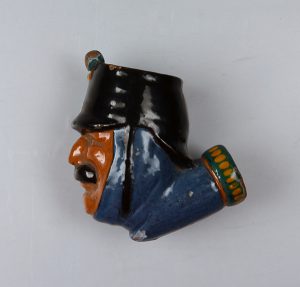
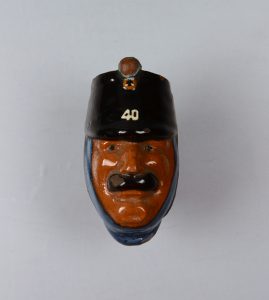
According to family lore, after the First World War Fritz Brechbühl created his own tobacco pipe bowl in the shape of a soldier from the 40th Mountain Infantry Battalion. The battalion was Brechbühl’s own battalion and had been stationed in Langnau. It existed from 1874 to 1937 and had been mobilised as early as 3rd August 1914 (Glanzmann 2012, 44-47). We cannot verify if this was actually true, or if it was just a good story, as identical pipe bowls exist with other battalion numbers on them, which would suggest that such memorabilia were made in larger numbers by an unidentified workshop.
Acknowledgements:
We would like to thank Christian Wüthrich (1924-2020) and his sons and their families for welcoming us to the house in Langnau and for all the conversations, pieces of information and archival records about the Röthlisberger pottery they have generously shared with us over the years. Without this background information, we would never have been able to write this piece. We are also grateful to Hans Brechbühl, Langnau, who gave us access to his inherited pottery collection and allowed us to use it for documentary purposes.
Translation: Sandy Haemmerle
References:
Bodmer-Huber/Messerli-Bolliger 1986
Ernst Bodmer-Huber/Barbara E. Messerli-Bolliger, Die Tonwarenfabrik Bodmer in Zürich-Wiedikon Geschichte, Produktion, Firmeninhaber, Entwerfer, in: Keramikfreunde der Schweiz, Mitteilungsblatt, 101. Jahrgang, 1986, 1-60.
Blondel 2001
Nicole Blondel, Céramique: vocabulaire technique, Paris 2001.
Conradin 1914
Christian Conradin, Der Bazar im Dörfli, in: Heimatschutz. Zeitschrift der Schweizer. Vereinigung für Heimatschutz 9, 1914, Heft 6, 89-98.
Glanzmann 2012
Jonas Glanzmann (Red.), 100 Jahre Offiziersgesellschaft Langnau und Umgebung. Eine Chronik von 1912 bis 2012. Langnau 2012.
Heege 2019
Andreas Heege, Keramik aus St. Antönien. Die Geschichte der Hafnerei Lötscher und ihrer Produkte (1804-1898) (Archäologie Graubünden – Sonderheft 7), Glarus/Chur 2019.
Heege/Kistler 2017
Andreas Heege/Andreas Kistler, Keramik aus Langnau. Zur Geschichte der bedeutendsten Landhafnerei im Kanton Bern (Schriften des Bernischen Historischen Museums 13), Bern 2017.
Hermanns 1914
Jacob Hermanns, Keramik und Glas an der Schweiz. Landesausstellung. Die Schweiz: Schweizerische illustrierte Zeitschrift 18, 1914, 376-378.
Kiefer 1914
Georges Kiefer, 23: Gruppe: keramische und Glaswaren. Schweizerische Landesausstellung in Bern 1914, Fachberichte Band VI.
Messerli 2017
Christoph Messerli, 100 Jahre Berner Keramik. Von der Thuner Majolika bis zum künstlerischen Werk von Margrit Linck-Daepp (1987-1983). Hochschulschrift (Datenträger CD-ROM), Bern 2017.
Stauder 1917
Hermann Stauder, Die Töpferei im Heimberg (Nachdruck des Kunst- und Kulturverein Heimberg, 1985, Original Schweizerische Landesbibliothek Bern), Bern 1917.
Wyss 1906
Paul Wyss, Stand, Probleme und Hebung des Töpfergewerbes. Nach dem Vortrage von Hrn. P. Wyss … in Bern niedergeschrieben von H[ermann] Röthlisberger, Sek.-Lehrer in Steffisburg. Oberländer Volksfreund / Hrg. vom Handwerker- und Gewerbeverein Steffisburg. Jahrg. 1, 1906, No 14-19 (Original in der schweizerischen Nationalbibliothek Bern; http://permalink.snl.ch/bib/sz000875648).

